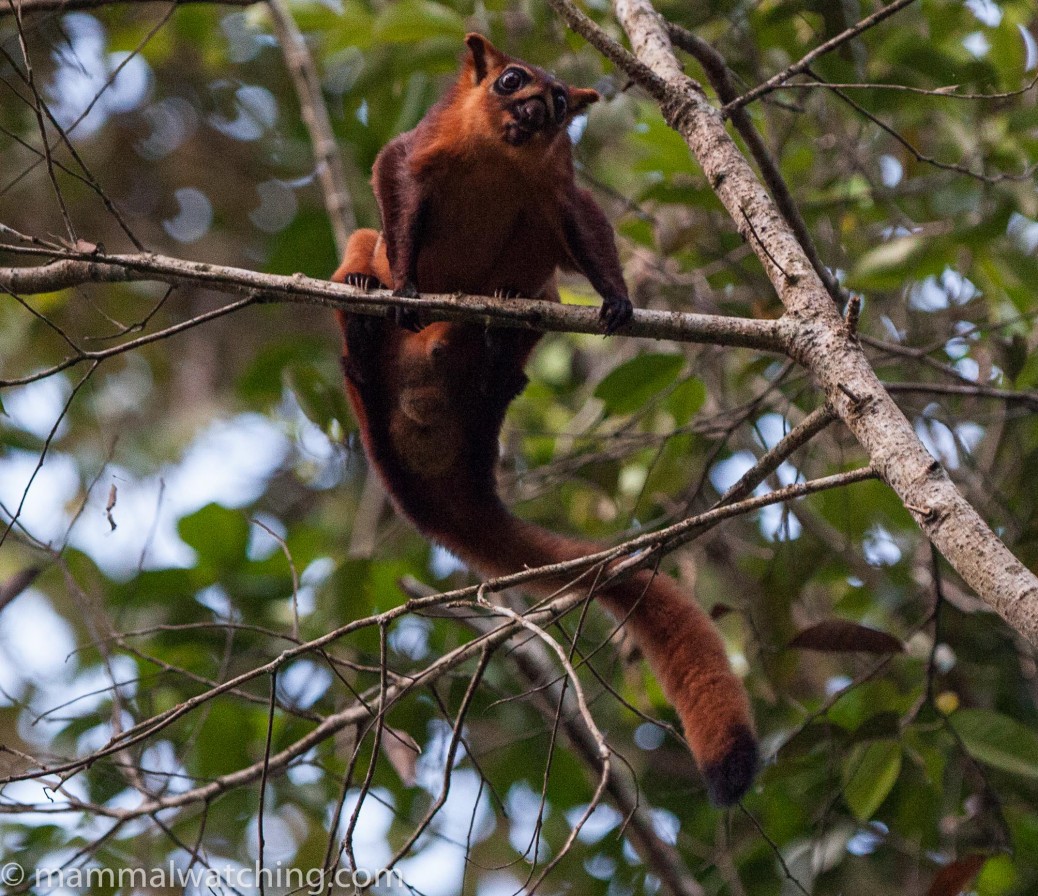
Sumatra and the Mentawai, Natuna and Riau Islands
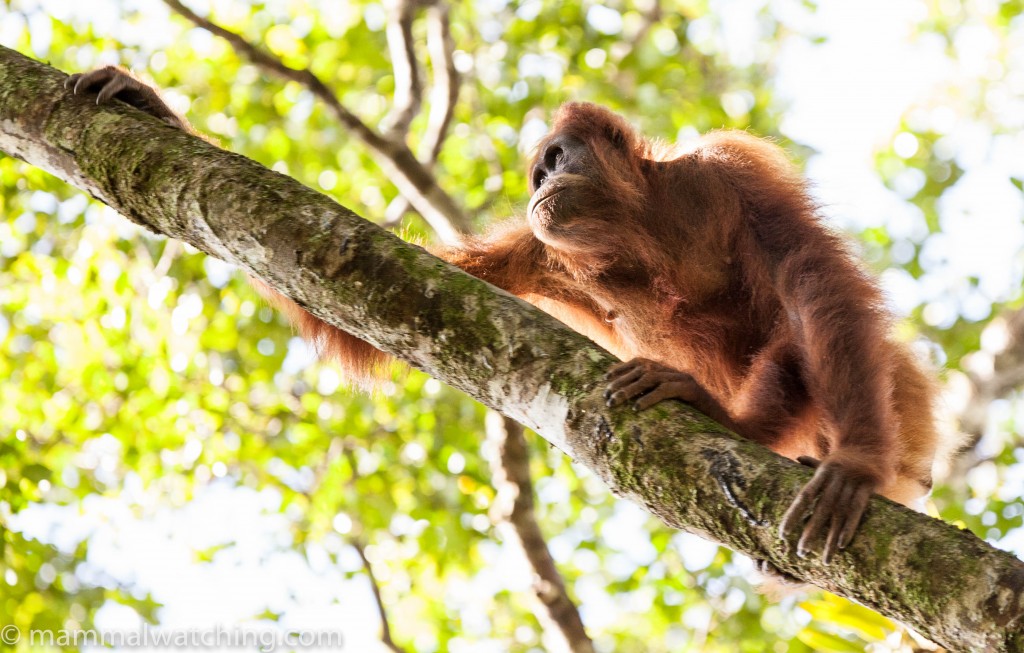
Sumatran Orangutan, Pongo abelii, Gunung Leuser
I spent the last week of May 2015 in Sumatra, with Jean-Michel Bompar (in Way Kambas only) and Tomer Ben-Yehuda (in both Way Kambas and Gunung Leuser). Our trip followed on from five days in Deramakot, Sabah (see the trip report here).
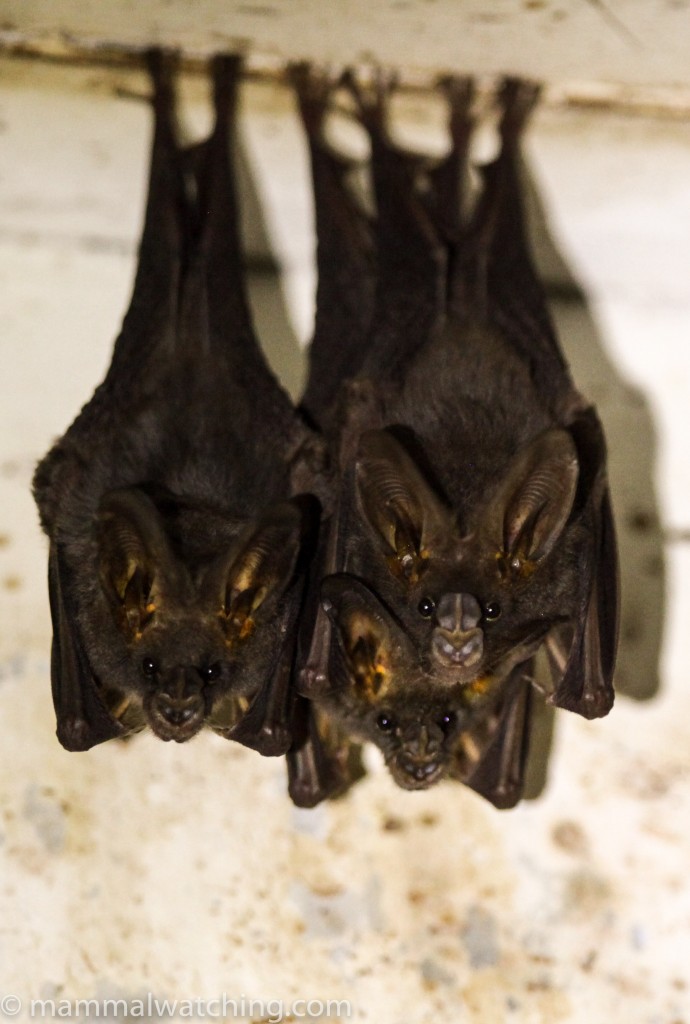
Lesser False Vampire Bats, Megaderma spasma, Way Kambas
Way Kambas
In the early 2000s some Australian birding friends delighted in telling me they had seen a Sun Bear at Way Kambas in Sumatra. Bastards. The national park has been on my radar ever since. Over the past few years it began steadily moving up the ranks of places I had to visit. A mouth watering list of specialities was starting to emerge including Marbled Cat, Pen-tailed Tree Shrew and occasional Sun Bears and Otter Civets.
We traveled in late May because it was a period when the weather ought to be OK. Plus Hari, the legendary Way Kambas guide, would also be available to guide us. In retrospect it might have been better to have visited later in the dry season, i.e. July or August. Although it rained only once while we were a little early as the dry season had started late in 2015. Hari felt that a number of species, including Marbled Cat and Otter Civet, would be easier to see later in the season.
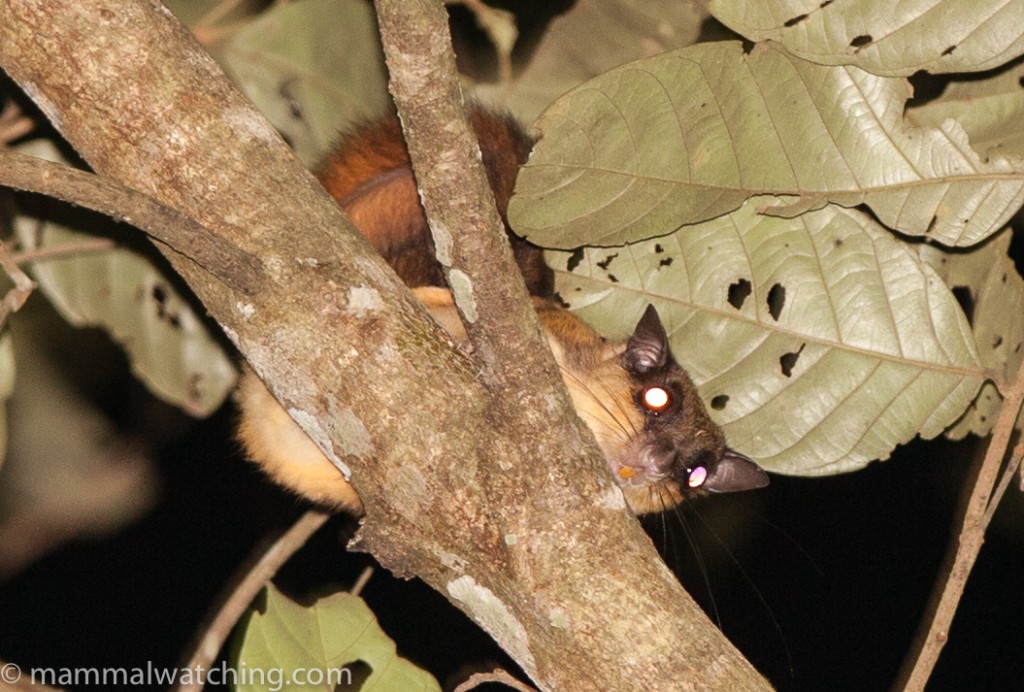
Horsfield’s (Javan) Flying Squirrel, Iomys horsfieldii
I organised the trip through Ecolodges Indonesia, who run the Satwa Elephant Lodge, just outside Way Kambas, and, even more importantly, employ Hari – or Hari Potter as I christened him – the magical mammal guide).
When Richard Webb visited in 2013 he reported paying around $3400 for two people for almost two weeks in Way Kambas and Java. We were charged $4600 for 3 people for five days and nights (based on Richard’s costs I’d initially expected to pay less than half of that). I repeatedly queried why the price had risen so much but the only explanation was that fuel prices had risen as had the national park entry fees. Indonesia is not an easy place to do business.
The prices, while not ridiculous, were close to unreasonable. That said, the lodge is comfortable, Nyoman, in the office, organised everything very efficiently, and delivered what they promised. Hari is also an extremely good guide, ready to work 24 hours a day to find us mammals.
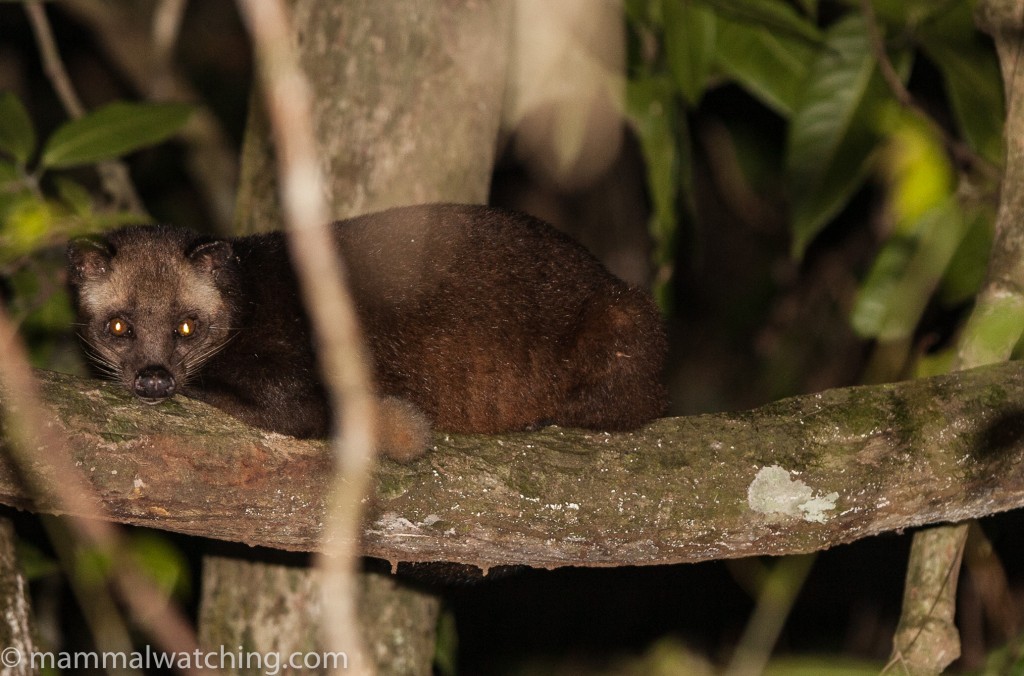
Masked Palm Civet, Paguma larvata
The Set Up
Richard’s report gives some excellent information on the park and its set up. I won’t repeat it here and also try to follow his road naming conventions etc.
We visited the park twice a day, following a mammal boot camp regime that was presumably inspired by Richard! Into the park at 4.30 a.m., breakfast at the substation inside, and back to the hotel by about 10.30 a.m. We generally took an early lunch, then a long nap, returning to the park at 3.30 p.m. until midnight. Trips were a mixture of driving – and walking – along the only road through the park. We also took river trips four times.
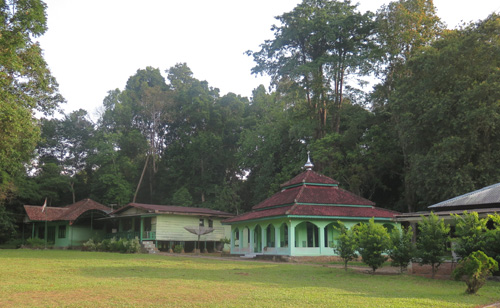
Way Kambas Substation
On the plus side, Hari’s great spotting skills aside, the Satwa truck is well set up for spotlighting with three rows of bench seats in the back.
On the negative side, the truck is noisy and the transmission was problematic (at least when our driver was using it). Communication with the driver was sometimes more than a little fraught. All commands to “stop” , “go back” etc had to be relayed through Hari and even he didn’t always have success in communicating the correct direction. Our driver also fell asleep at the wheel late one night, and the truck slowly slid into the storm drain at the side of the road. We had to be rescued. This led to a certain nervousness on my part during every drive that followed and I had one eye on the forest and the other on the driver.
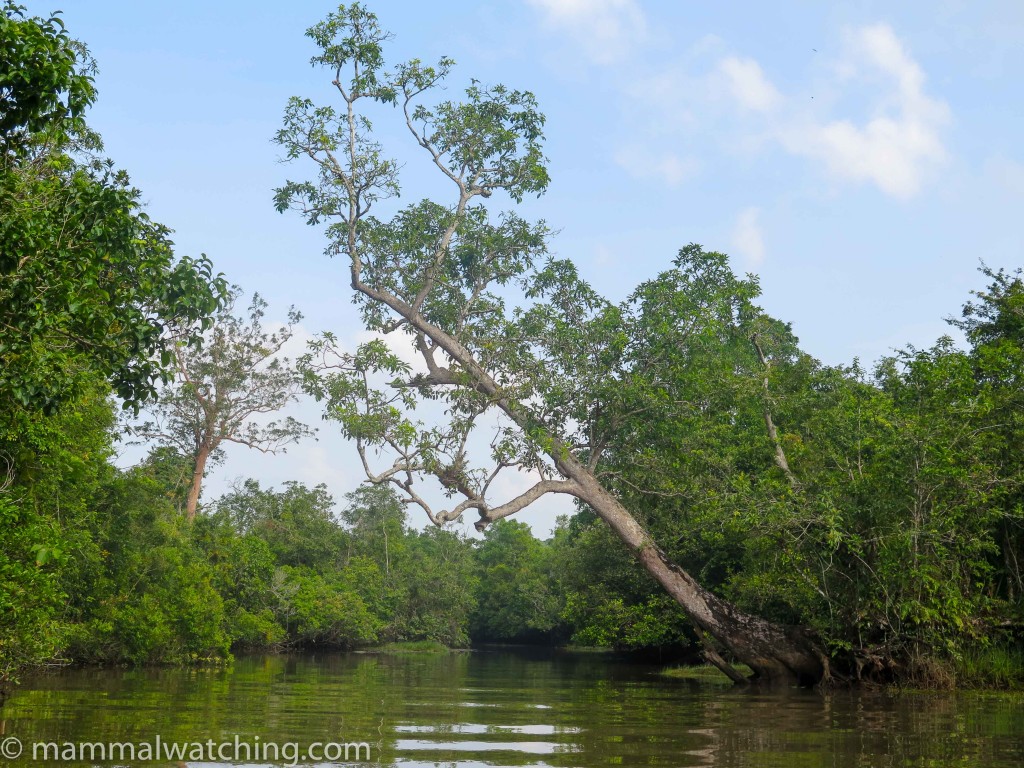
Way Kanan River
The river trips also rely, for the moment at least, on a dreadful boat belonging to the national park. The 40 hp outboard sounded like a cross between a jackhammer and a Harley Davidson (one of the big ones), and belched more smoke than a Space Shuttle launch. Whenever we stopped we’d be enveloped in a fog of thick diesel fumes. The bumbling crew, Laurel and Hardy, appeared never to have left dry land, so any attempt to approach an animal using the paddles would usually result in our spinning circles and crashing into the bank. This was a source of amusement more than frustration most of the time, though Tomer appeared close to developing an aneurysm once or twice.
On our last night, Hari left half of the crew behind and commandeered the driving for himself. This was much more effective. He also told us that Satwa were planning to buy their own boat – with an electric motor – later this year. This will be very welcome as the river trips ought to be really good. Other than a few leeches we encountered no stinging or biting things in the forest.
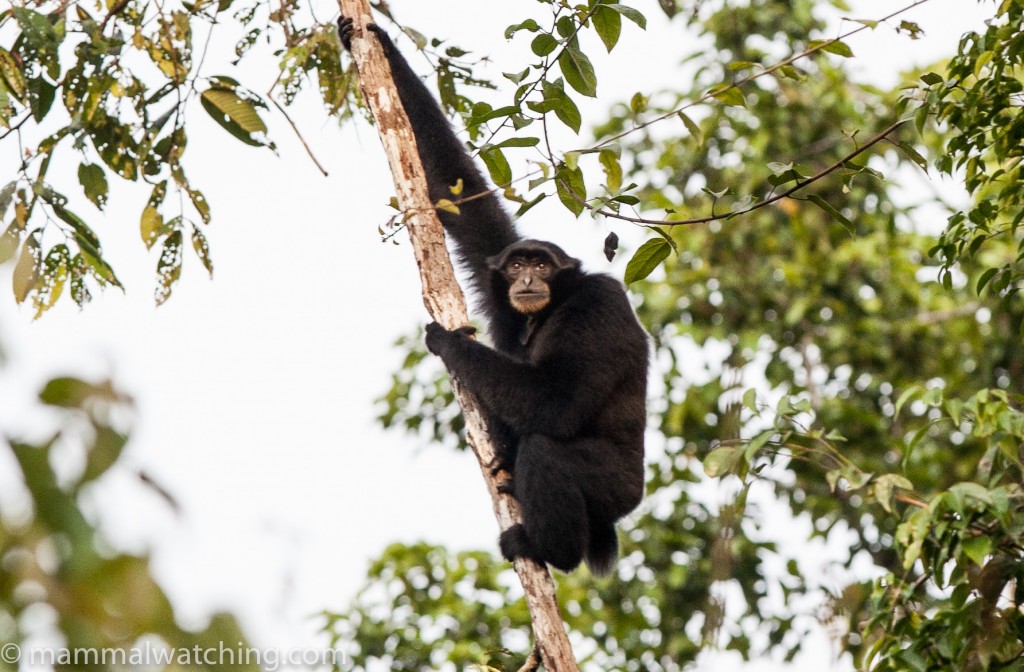
Siamang, Symphalangus syndactylus
The Mammal Watching
Richard’s report has a lot of great information and I won’t repeat it here. Most of it still seems current, though one small – but important – point is that Otter Civet, while rare, is not as rare as Richard thought. Hari has seen them several times with several being “more than 10” (though I suspect not much more than 10).
We were free to design our own schedule, but we followed Hari’s lead and took the boot camp regime I described earlier (04.00-10.30 and 15.30 – 24.00 in the field).
Mammal watching was something of a challenge, especially after the tall trees and wide road at Deramakot. Most of the secondary forest in Way Kambas has dense undergrowth so a lot of eyeshine was destined to remain just that. A number of doubtless interesting species went unidentified. We tried not to fall into the trap of turning a vague shape into a Marbled Cat, though conversations along those lines are inevitable.
Hari is excellent at identifying animals before the rest of us, and always called them correctly. During the day Hari was also really good at getting us close to the primates, knowing their calls and predicting their behaviour.
River trips could be great at night with a reasonable chance for Tapir and Otter Civets, but the national park boat is a disaster. When Satwa get their new boat things will improve (see comments in the previous section).
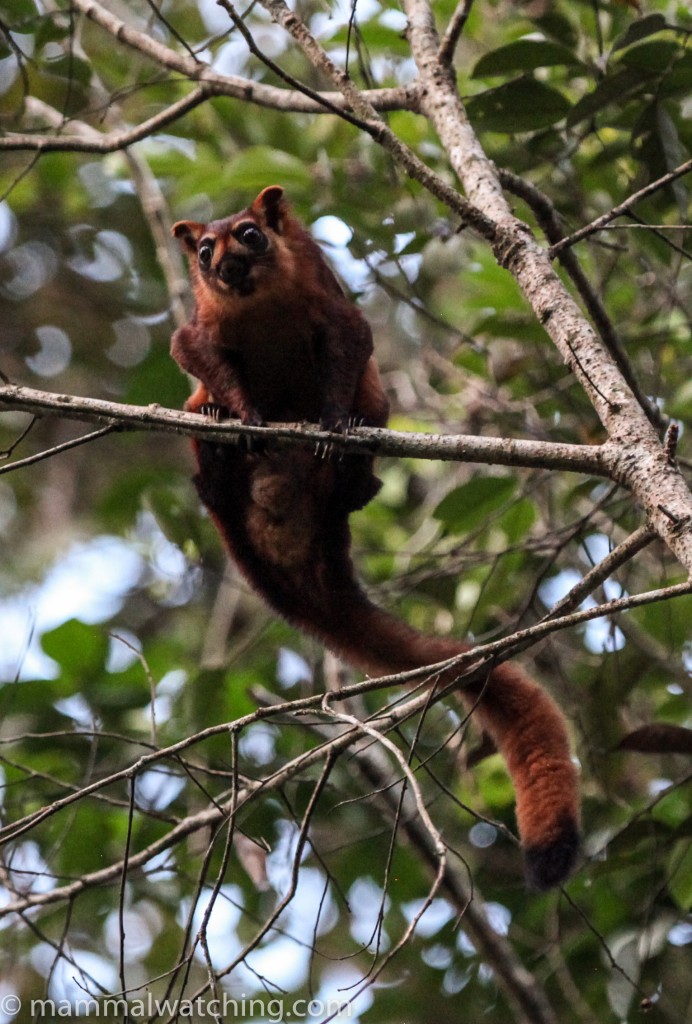
Red Giant Flying Squirrel, Petaurista petaurista
Every excursion was spent driving and walking along the road and sometimes taking a boat cruise. We took a boat trip once in the morning, and during three of our five nights. We may well not have taken more than one night cruise had I not been desperate to get a decent look at the Otter Civet we saw (but I saw very badly) on the first trip.
We had breakfast in the forest every day and dinner most nights too, though we came back to the lodge for dinner twice and during one of these caught a few bats in the hotel garden.
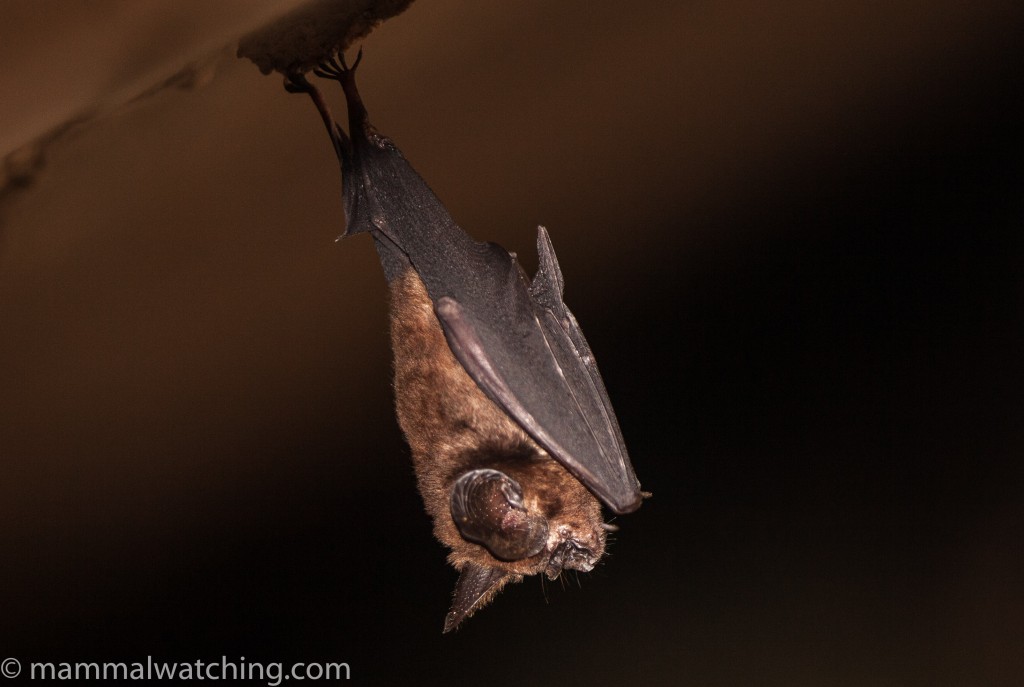
Orb-faced Roundleaf Bat, Hipposideros orbiculus
Hari was good at keeping track of the species we’d seen and helping to add new ones each day. Jean-Michel and I also checked for roosting bats in just about all the culverts and bridges along the road, as well as in the abandoned buildings at the substation and park gate.
The following lists show the diversity of sightings on each excursion into the park,
Friday 22 May
Afternoon: Sumatran Treeshrew (Tupaia ferruginea – now split from T. glis) and Plantain Squirrel (in the hotel garden), Long-tailed Macaque, Silvered Langur, Mitred Langur, Prevost’s Squirrel, Black-banded Squirrel, Southern Red Muntjak, Lesser Asian Sheath-tailed Bat, Orb-faced Roundleaf Bat, Greater Woolly Horseshoe Bat.
Evening: Lesser False Vampire Bat, Annandale’s Rat, Common Palm Civet, Sambar, Red Giant Flying Squirrel, Lesser Mouse Deer, Greater Mouse Deer, Southern Red Muntjak.
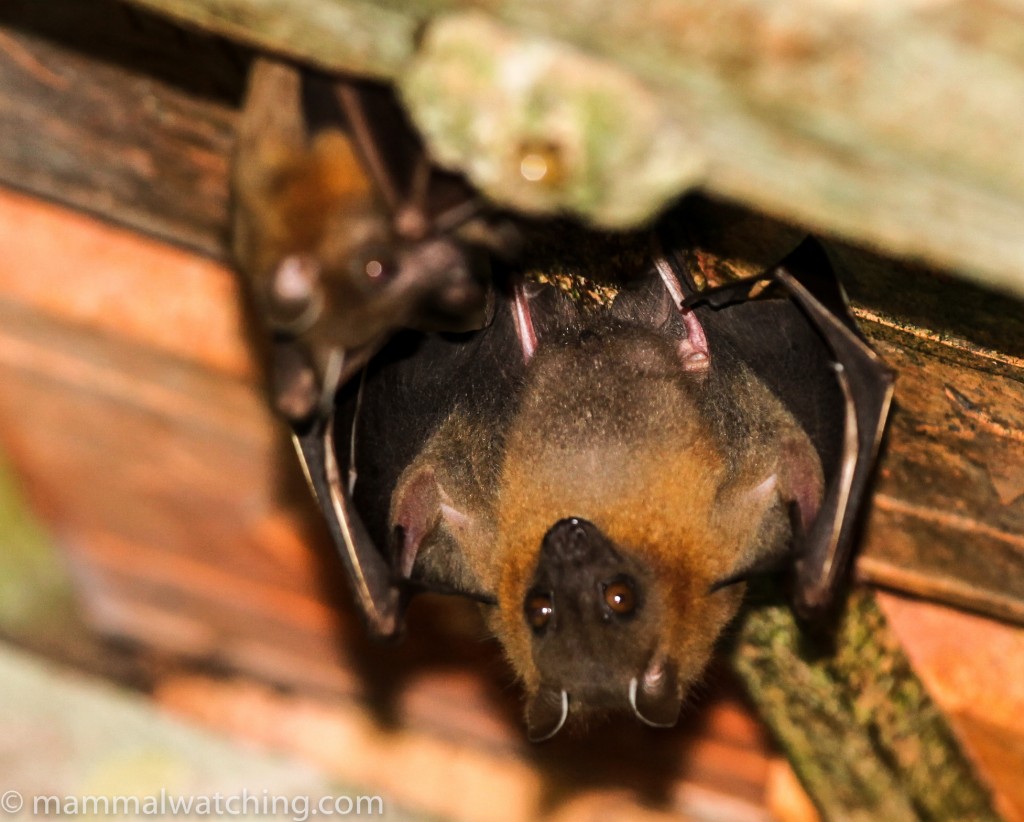
Minute Short-nosed Fruit Bat, Cynopterus minutes
Saturday 23 May
Morning: Masked Palm Civet, Lesser Mousedeer, Minute Short-nosed Fruit Bat, Lesser Treeshrew, Siamang, Black Giant Squirrel, Malaysian Slit-faced Bat, Black-eared Pygmy Squirrel.
Evening: Horsfield’s Flying Squirrel, Pen-tailed Tree Shrew, Common Palm Civet, Masked Palm Civet, Lesser Mouse Deer, Southern Red Muntjak, Sambar Deer, Sunda Slow Loris; and we caught Forest Short-nosed Fruit Bat, Geoffroy’s Rousette and Dyak Fruit Bat in the hotel garden.
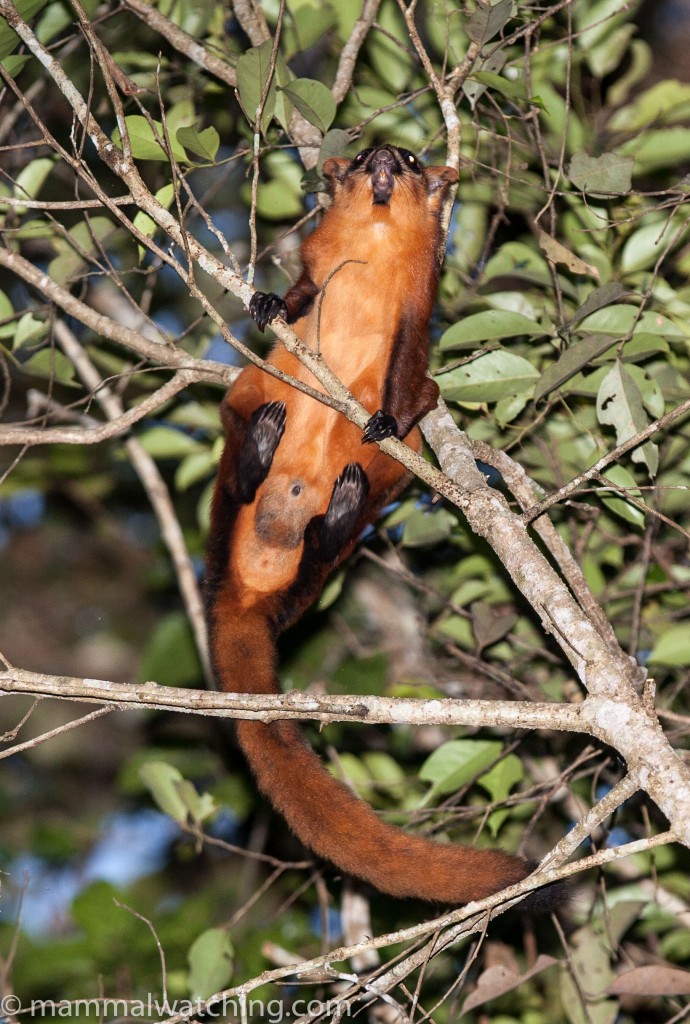
Red Giant Flying Squirrel, Petaurista petaurista
Sunday 24 May
Morning (including a boat trip): Silvered Langur, Long-tailed Macaque, Prevost’s Squirrel, Plantain Squirrel, Southern Red Muntjak, Lesser Mouse Deer, Sambar, Malaysian Wood Mouse (caught at the hotel).
Evening (including a boat trip): Southern Red Muntjak, Prevost’s Squirrel, Lesser Mouse Deer, Greater Mouse Deer, Silvered Langur, Long-tailed Macaque, Otter Civet, Island Flying Fox, Pen-tailed Treeshrew, Banded Palm Civet, Red Giant Flying Squirrel, Southern Red Muntjak.
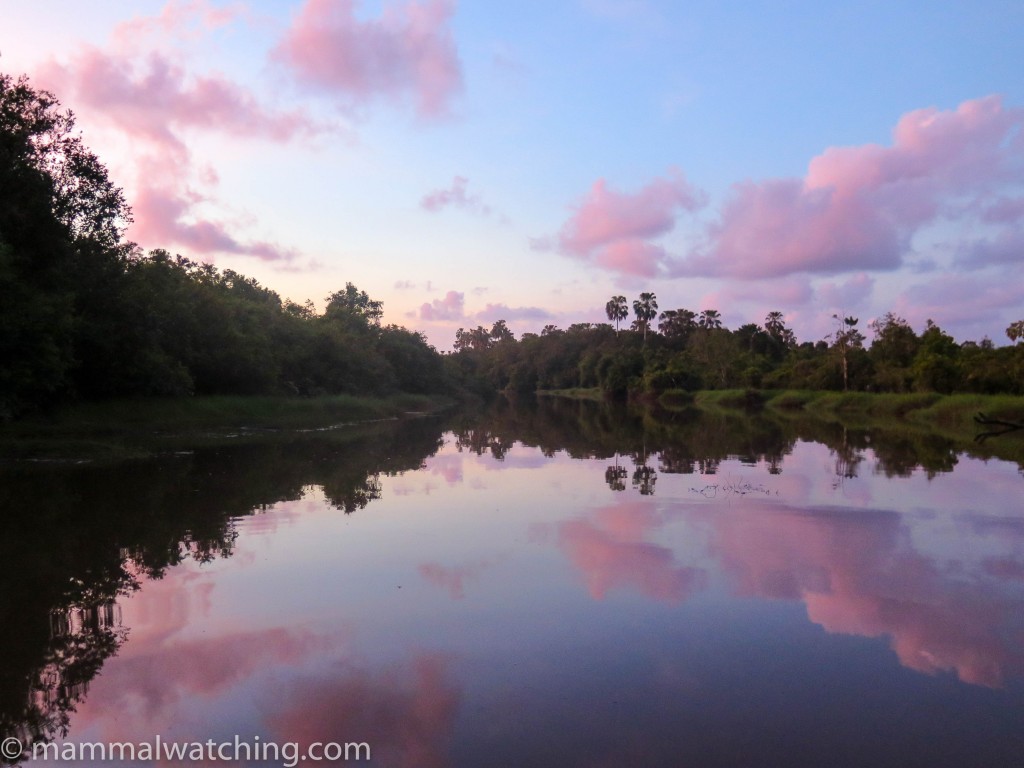
Way Batin River
Monday 25 May
Morning: Pig-tailed Macaque, Long-tailed Macaque, Siamang, Agile Gibbon, Masked Palm Civet, Lesser Treeshrew, Sumatran Treeshrew, Wild Boar, Orb-faced Roundleaf Bat, Slender Squirrel, Black-eared Pygmy Squirrel.
Evening (including a boat trip): Siamang, Southern Red Muntjak, Minute Short-nosed Fruit Bat, Long-tailed Macaque, Silvered Langur, Otter Civet (possibly), Lesser Mouse Deer, Greater Mouse Deer, Sambar, Malay Civet, Leopard Cat, Lesser Mouse Deer, Red Giant Flying Squirrel.
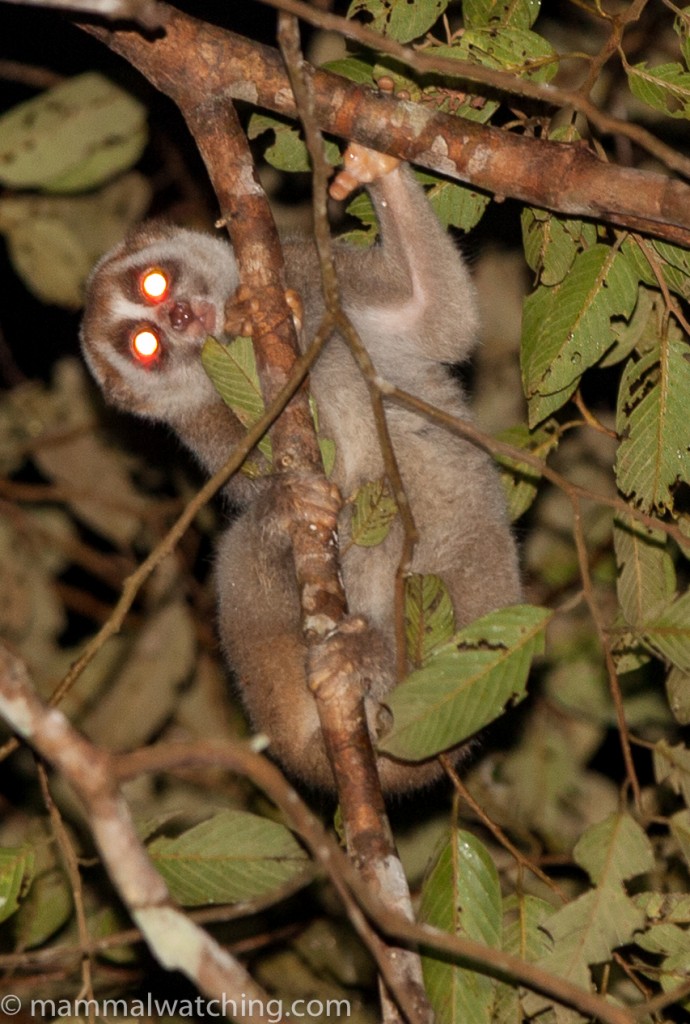
Sunda Slow Loris, Nycticebus coucang
Tuesday 26 May
Morning: Mitred Langur, Provost’s Squirrel, Robinson’s (Low’s) Squirrel, Wild Boar, Southern Red Muntjak, Sambar, Three-striped Ground Squirrel (heard), Lesser Mouse Deer, Orb-faced Roundleaf Bat, Lesser False Vampire Bat.
Evening (including a boat trip): Siamang, Long-tailed Macaque, Red Giant Flying Squirrel, Three-striped Ground Squirrel, Masked Palm Civet, Lesser Mouse Deer, Southern Red Muntjak, Sambar.
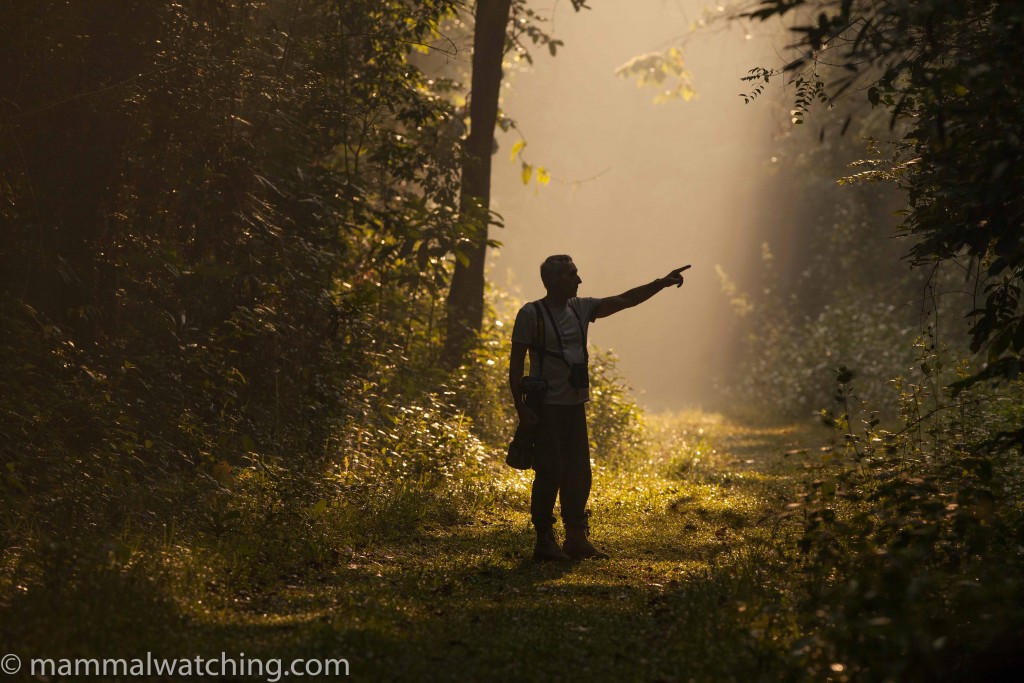
Jean-Michel spots a squirrel
Species Account
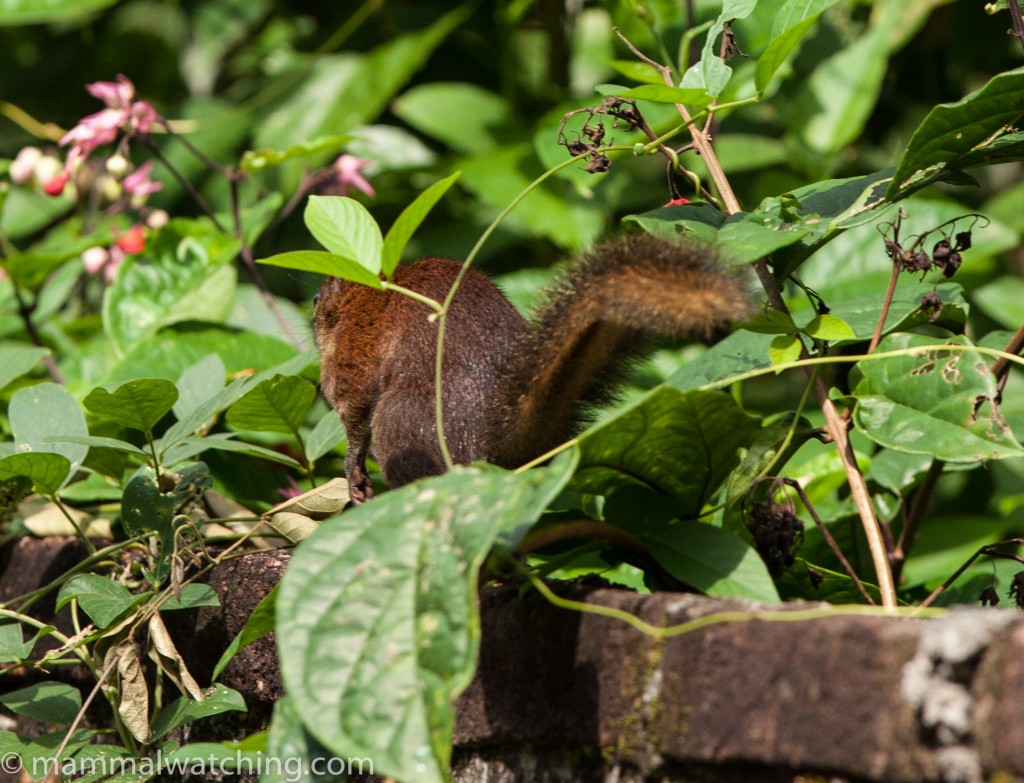
Common Tree-Shrew Tupaia glis
Common Tree Shrew: Easily seen around the garden of the Satwa Lodge. At least two others seen along the road in the park.
Lesser Tree Shrew: We spotted at least three of these on different days along the park road (usually when searching for Pygmy Squirrels).
Pen-tailed Tree Shrew: One of the Way Kambas specialties. I’ve not heard of anyone seeing this remarkable species anywhere else. And yet Hari now knows a few spots to see them along the road. They move extremely quickly and are hard to get onto. I spotted the first, less than a kilometre from the park entrance gate, zipping along a branch across the road. Hari saw another, along the lower jeep track, dashing through vines about 5 metres up. I got a brief look at it through my binoculars though I didn’t see the tail, which is the most interesting bit. Interestingly Hari said that they sometimes appear to be attracted to – or confused by – the torch beam.
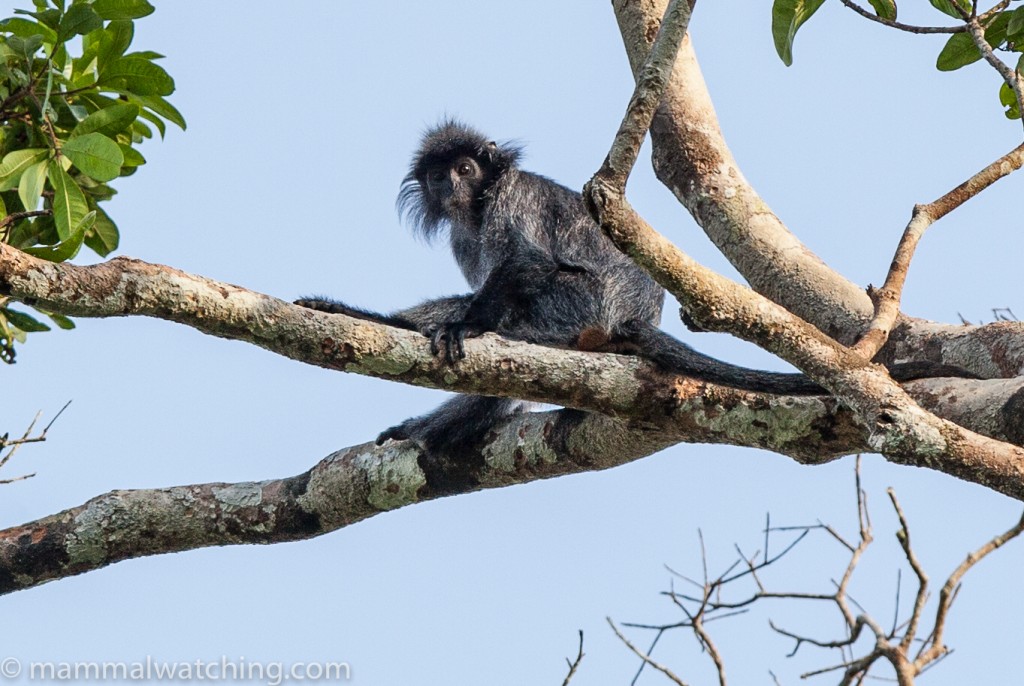
Silvered Langur (Leaf Monkey), Trachypithecus cristatus
Silvered Langur: We saw a few along the jeep track, but they were very common along the river during the boat trips.
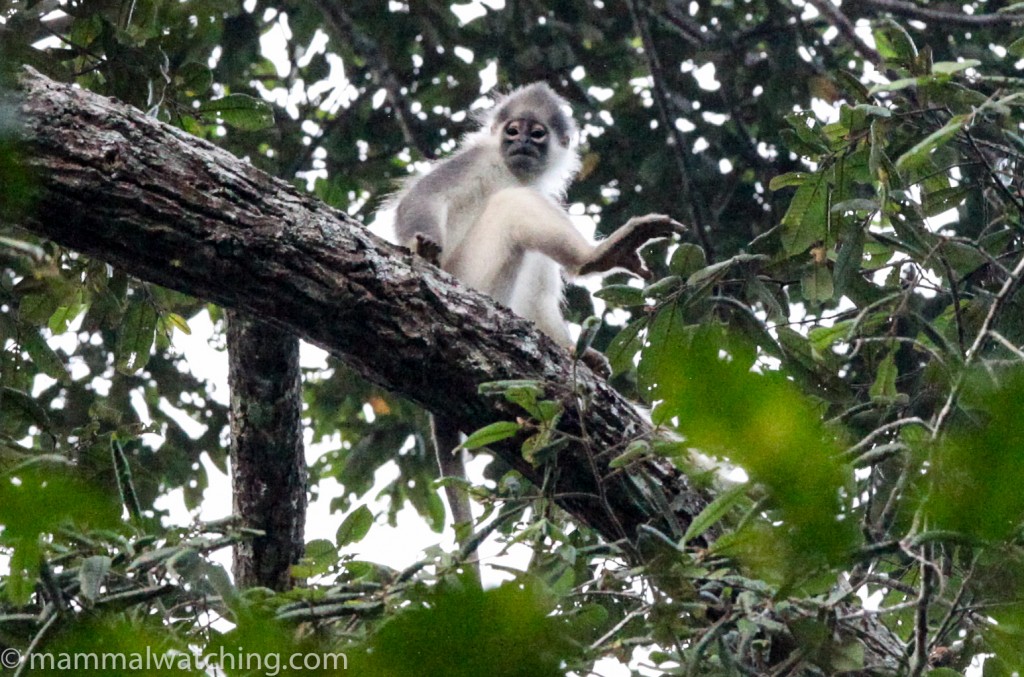
Mitred Langur (Leaf Monkey), Presbytis mitrata
Mitred Langur: We saw these on three occasions along the jeep track. In the late afternoon one sat still long enough for a photo, but generally they were shy and hard to approach.
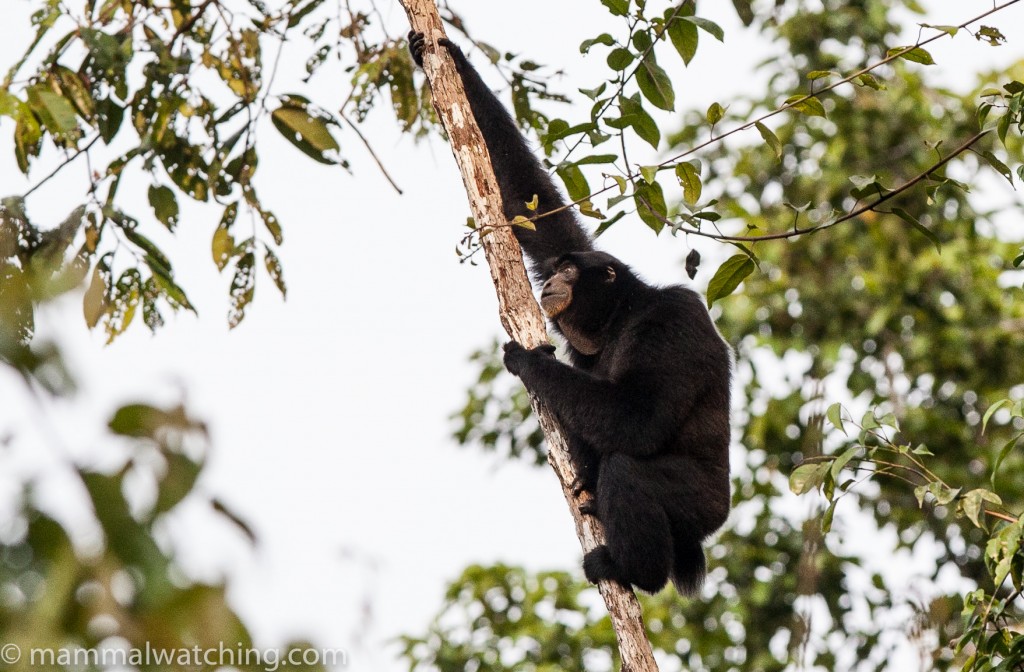
Siamang, Symphalangus syndactylus
Siamang: Impressive to see and to hear, they called very loudly each morning close to the road and could easily be tracked down.

Agile Gibbon, Hylobates agilis, photo Jean-Michel Bompar
Agile Gibbon: Hari was able to track a troop down early one morning. Apparently shyer, and rarer in the park, than the Siamangs, he heard two groups calling on either side of the road and correctly predicted that they would move closer to us. We got to within 50 metres for a decent look at them.
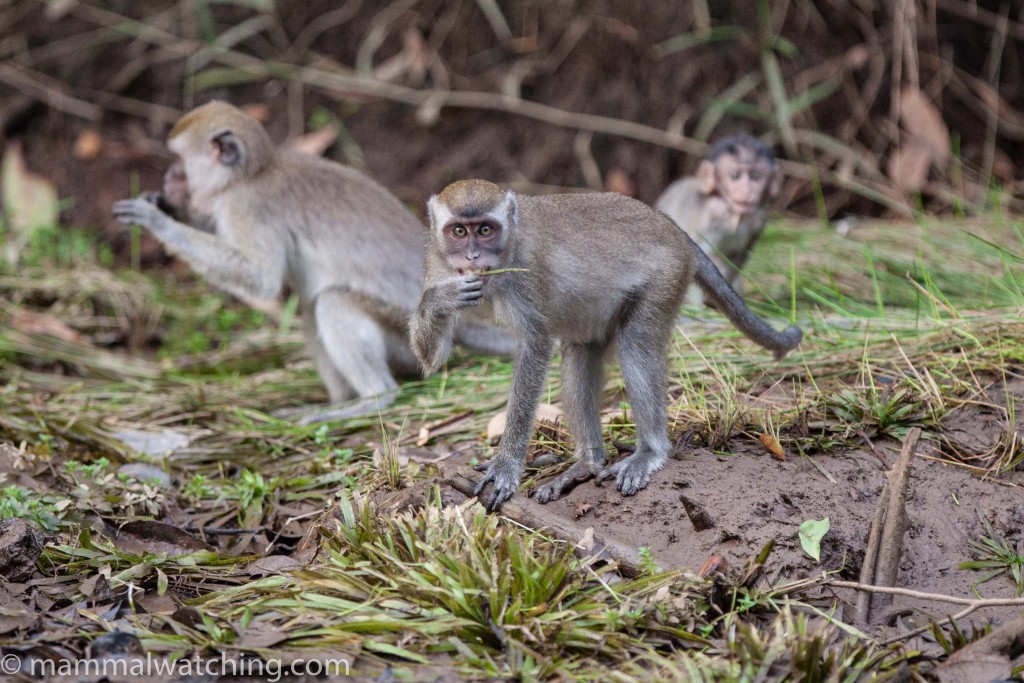
Long-tailed Macaque, Macaca fascicularis
Long-tailed Macaque: Very common along the river and the road.
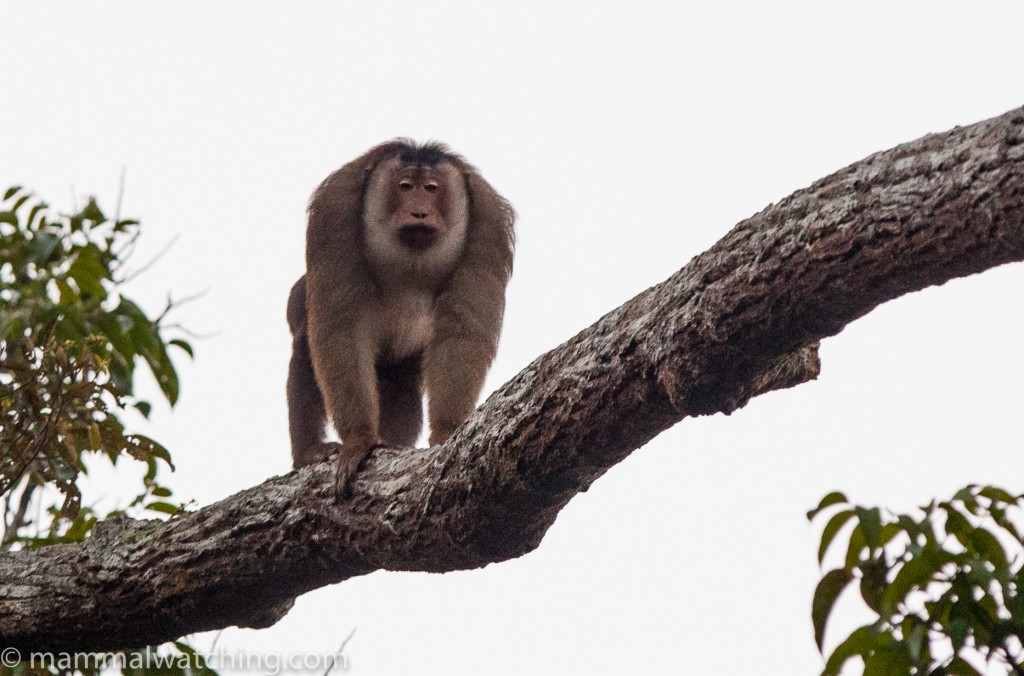
Sunda Pig-tailed Macaque, Macaca nemestrina
Pig-tailed Macaque: We saw a few along the river and the road.
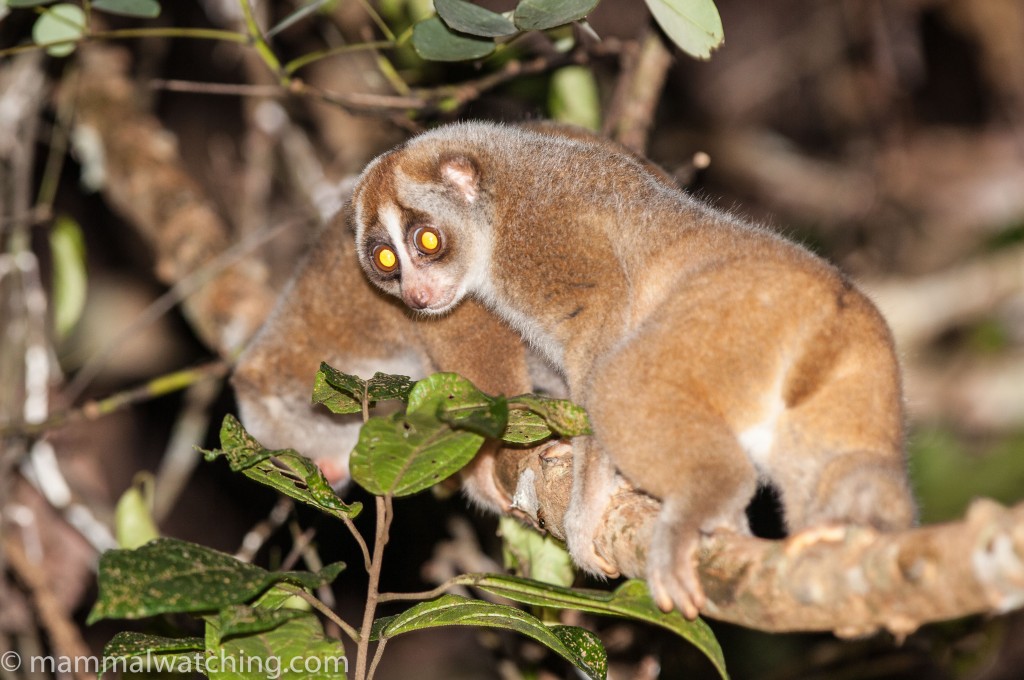
Sunda Slow Loris, Nycticebus coucang
Sunda Slow Loris: We saw animals twice during spotlighting sessions along the upper jeep track. One pair gave really excellent views.
Common Palm Civet: Seen on most night drives.
Small-toothed Palm Civet: Seen on one night drive.
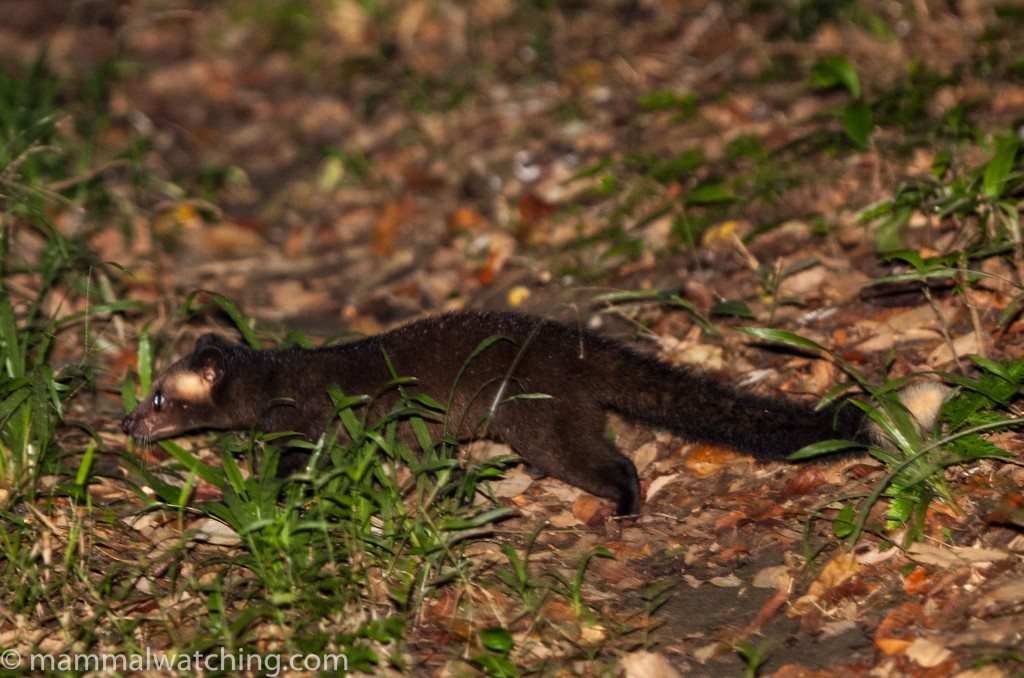
Masked Palm Civet, Paguma larvata
Masked Palm Civet: The most commonly seen civet by us at Way Kambas and seen most night drives. One group of three – presumably a mother with young – ran backwards and forwards around the car in response to our squeaking.
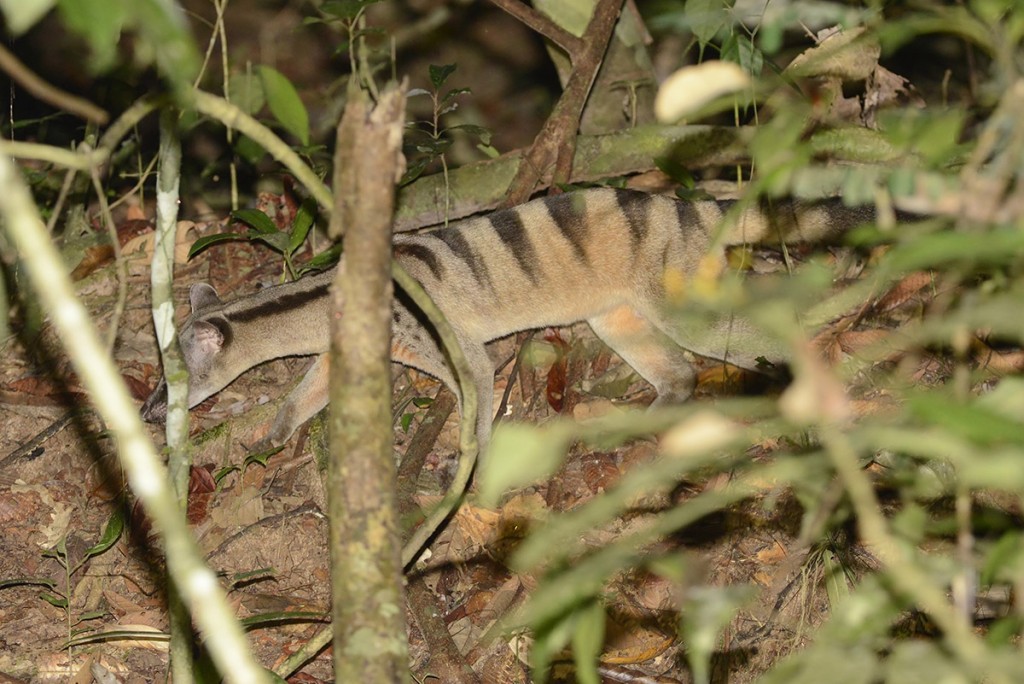
Banded Palm Civet, Paguma larvata. photo Jean-Michel Bompar
Banded Palm Civet: Another Way Kambas speciality, this beautiful species had eluded me until this trip (we also saw it in Deramakot). We saw a couple of animals on different night drives along the lower jeep track.
Otter Civet: One of the highlights of the trip. But, for me at least, also one of the lowlights because I only got an untickable glimpse. This species seems naturally rare everywhere but in Way Kambas they are seen a few times each year. Sometimes along the river, sometimes near a creek along the middle jeep track. Motoring back to the sub-station in the awful national park boat Jean-Michel spotted an animal moving through a clearing in the mangrove forest and Hari called “Otter Civet”. Both he and Jean-Michel got a clear look at the animal for a couple of seconds. By the time I got onto it the beast was only eyeshine and a vague blur of head. We returned to the same area the next night and got similar eyeshine, moving in a similarly lumbering fashion, about 100 metres away from our original sighting. I saw a clear silhouette of a civet-like animal – with no noticeable ears – which was quite probably an Otter Civet in my opinion. But we could not confirm the ID. The next night there was again eyeshine in the same place but deeper into the vegetation. This could have been any number of things (mouse deer are common along the river for example).
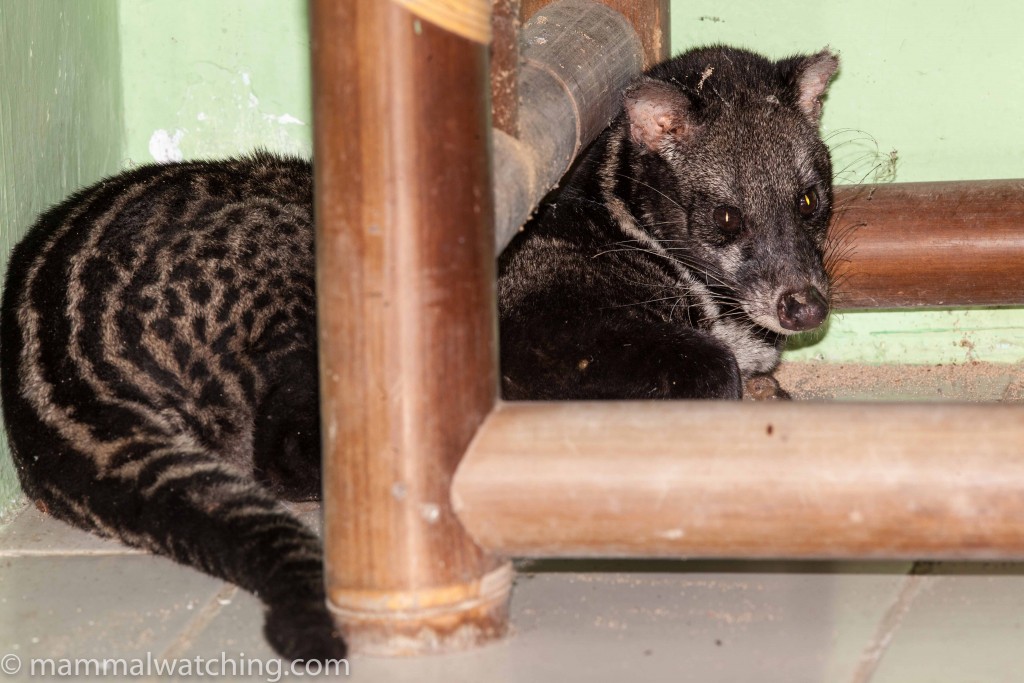
Malay Civet, Viverra tangalunga
Malay Civet: we saw a couple on right drives and another animal taking refuge under a table at the sub-station.
Leopard Cat: we saw at least 3 Leopard Cats according to Hari. We got a clear look at one.
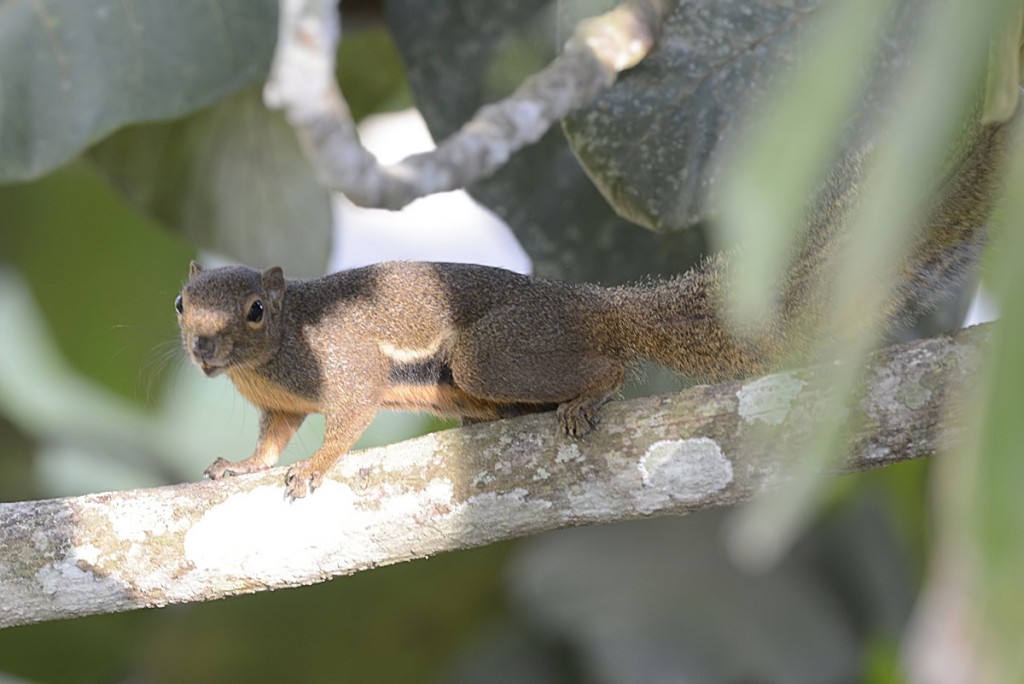
Plantain Squirrel Callosciurus notatus, photo Jean-Michel Bompar
Plantain Squirrel: Common around the lodge and along the track.
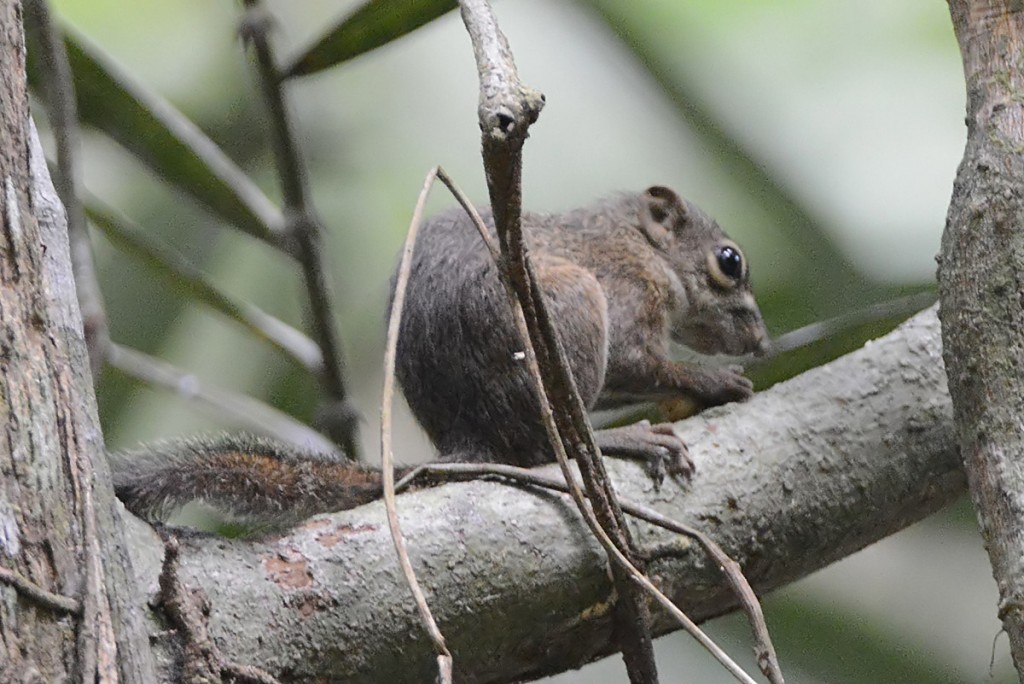
Slender Squirrel, Sundasciurus tenuis, photo Jean-Michel Bompar
Slender Squirrel: We initially mistook this small squirrel for the Black-eared Pygmy Squirrel. Seen just once along the jeep track and apparently fairly uncommon as Hari was not very familiar with the species.
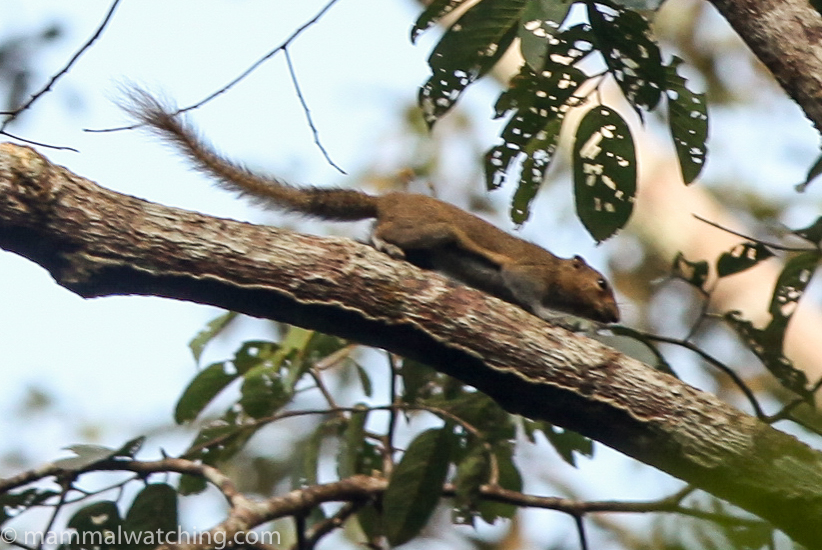
Black-banded (striped) Squirrel, Callosciurus nigrovittatus
Black-banded Squirrel: Common along the jeep track and seen daily.
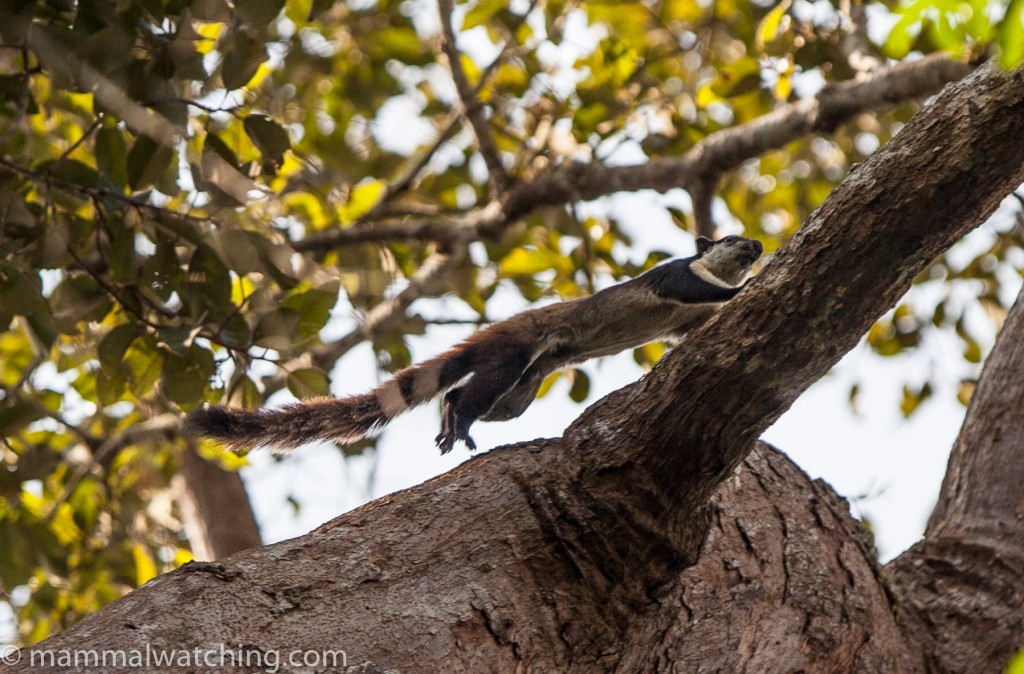
Black Giant Squirrel, Ratufa bicolor
Black Giant Squirrel: We saw one, and heard animals most days.
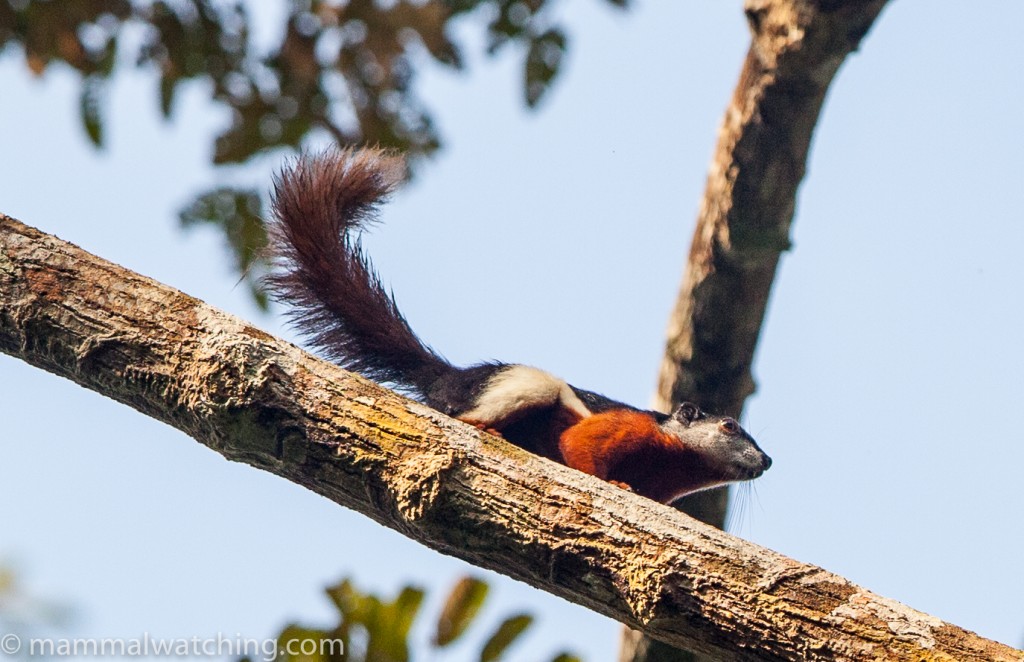
Prevost’s Squirrel, Callosciurus prevostii
Prevost’s Squirrel: Common in the park, with the race in Way Kambas (borneensis?) particularly attractive.
Black-eared Pygmy Squirrel: We struggled to get good views of this species despite seeing a couple of them in vine thickets along the road, though we missed them at the normal stakeout at the Way Batinh bridge despite putting in a fair amount of effort there.
Three-lined Ground Squirrel: Hari knows the call and heard this species a few times. A number of squirrels/treeshrews crossing the road may have been ground squirrels but we had just one confirmed sighting along the jeep track.
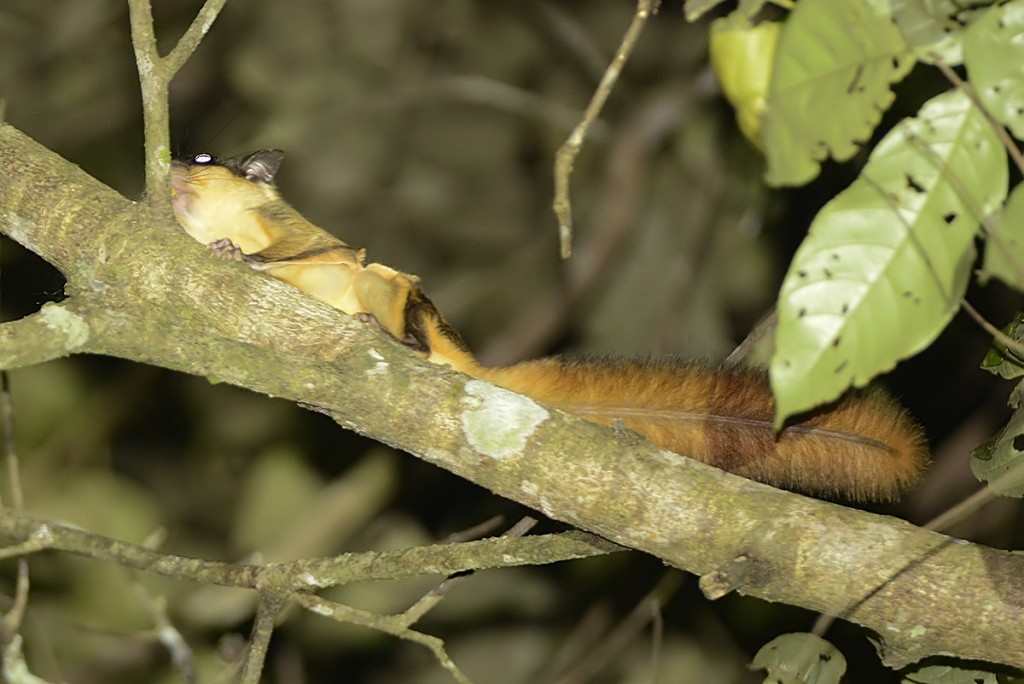
Horsfield’s (Javan) Flying Squirrel, Iomys horsfieldii
Horsfield’s Flying Squirrel: Jean-Michel picked up this pretty animal in the spotlight at about 7 p.m. on the middle jeep track. An unexpected sighting which posed obligingly for photos. Hari has not seen them often before.
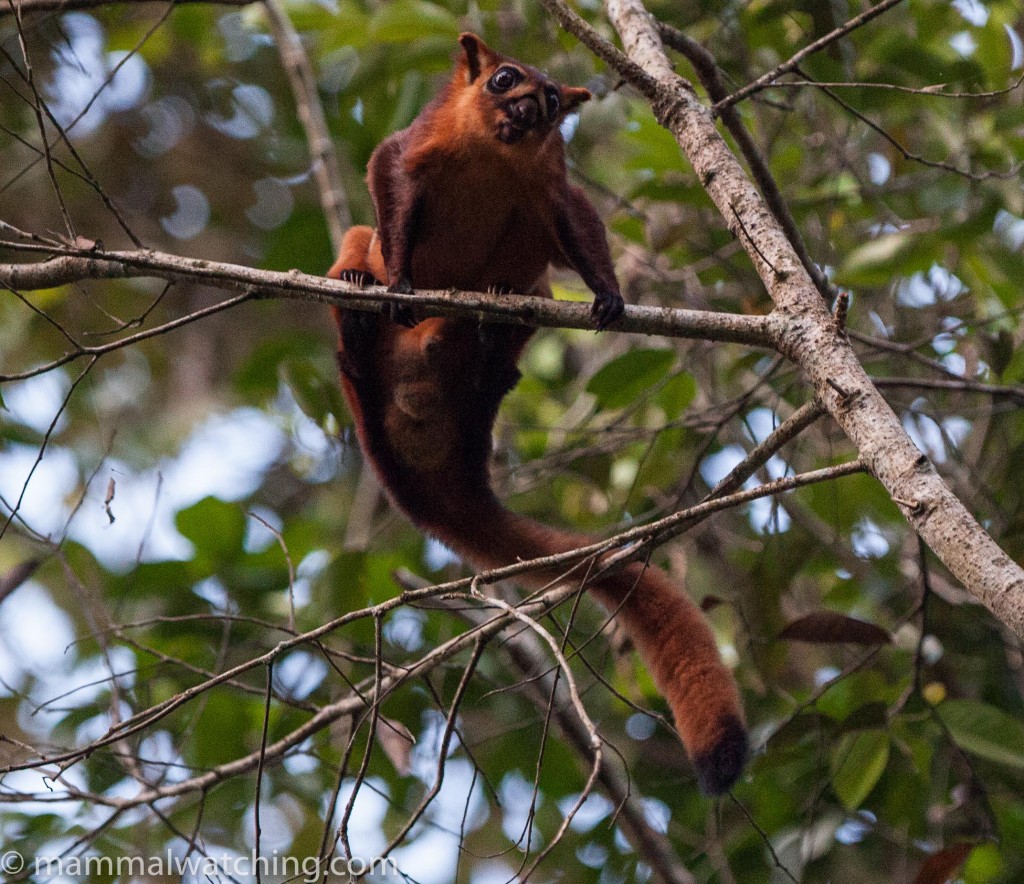
Red Giant Flying Squirrel, Petaurista petaurista
Red Giant Flying Squirrel: We saw at least four animals with the final sighting – before sunset on our last day – the best.
Lesser Mouse Deer: Seen after dark every day along the track and the river, though never very well. Most of the eyeshine we identified belonged to this species (though a good deal of eyeshine we picked up was never identified). Lesser Mouse Deer seemed to outnumber the Greaters by a ratio of about 3:1
Greater Mouse Deer: Seen after dark most days though less common than its smaller relative.
Sambar: Seen daily along the jeep track and river. The area just past the park entrance is a good place to see Sambar (if you really want to see one).

Southern Red Muntjac, Muntiacus muntjak
Southern Red Muntjak: Seen daily along the road.
Wild Boar: A sounder crossed the lower jeep track – near to the Rhino Sanctuary junction – on two separate mornings.
Island Flying Fox: A medium sized flying fox was flying over the mangrove forest during our first boat trip, about 90 minutes downstream of the Substation on the Way Batin river. Far too big to be a Cynopterus but too small to be a Large Flying Fox. It must have been this species.
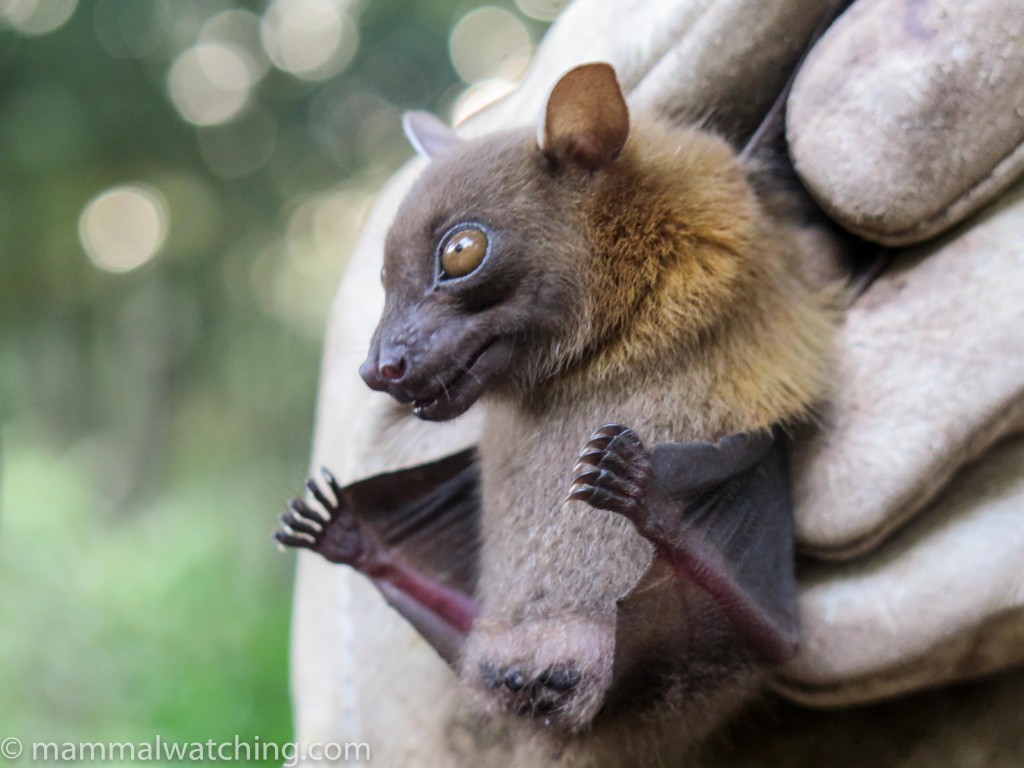
Minute Short-nosed Fruit Bat, Cynopterus minutus
Minute Short-nosed Fruit Bat: a few cynopterus were roosting at various spots around the substation – under the eaves of the main building and under a shelter near the boat launch steps. Jean-Michel caught one and the short forearm and yellowish-brown ruff suggest it was this species rather than the very similar C. brachyotis.
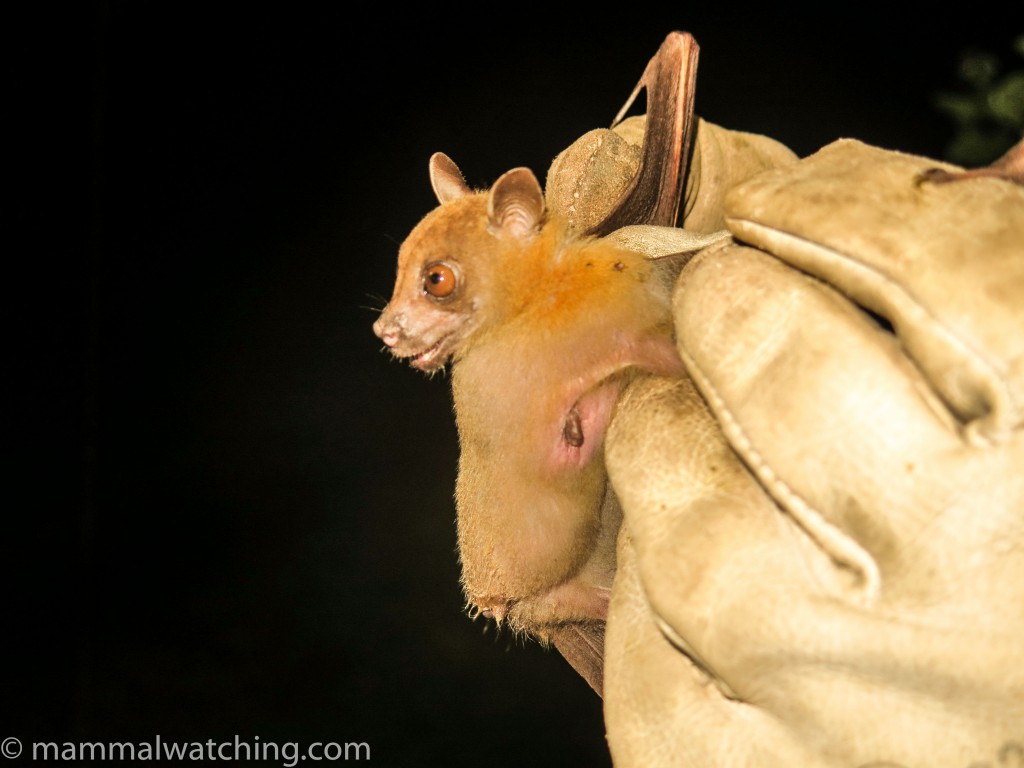
Forest Short-nosed Fruit Bat, Cynopterus brachyotis
Forest Short-nosed Fruit Bat: We set up a net in the gardens of Satwa Lodge one evening and caught a couple of these bats, slightly larger than the Minute species but otherwise very similar, although the ruff is more orange.
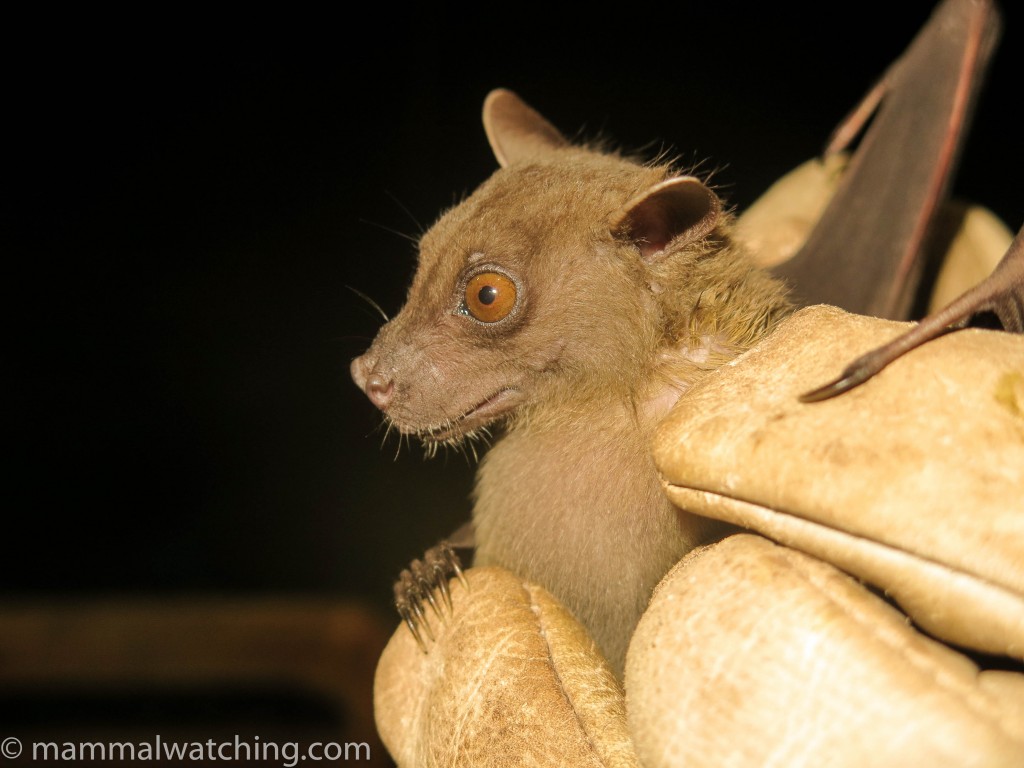
Dyak Fruit Bat, Dyacopterus spadiceus
Dyak Fruit Bat: We set up a net in the gardens of Satwa Lodge one evening and caught one of these bats.
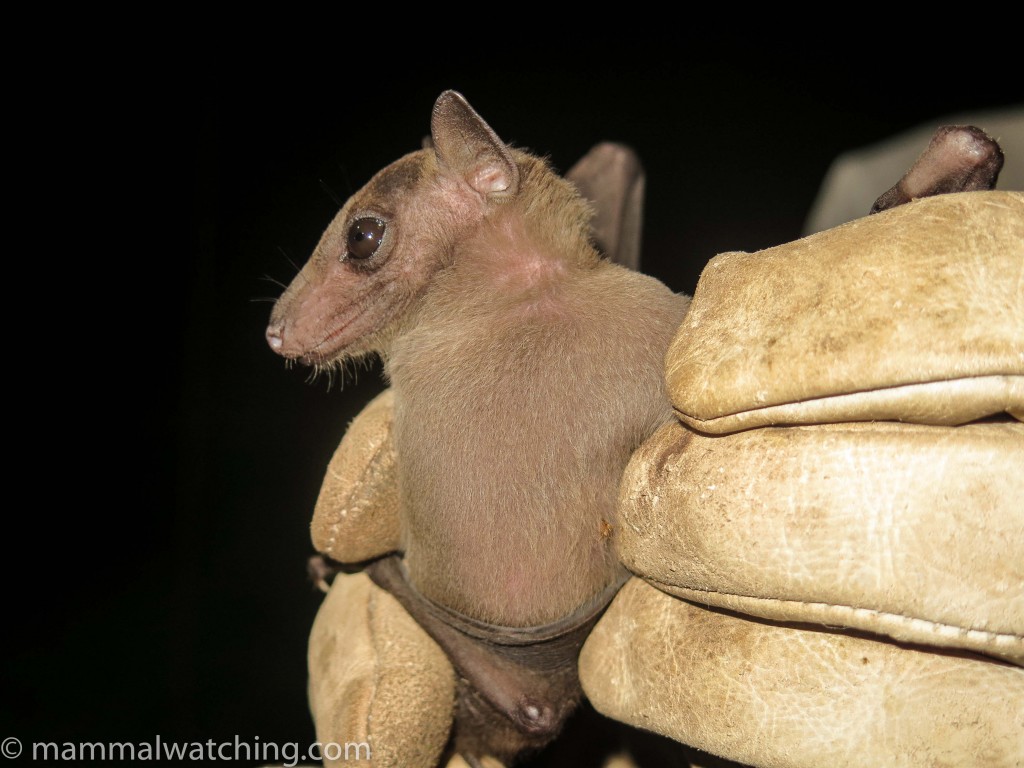
Geoffroy’s Rousette, Rousettus amplexicaudatus
Geoffroy’s Rousette: We set up a net in the gardens of Satwa Lodge on evening and caught one of these bats
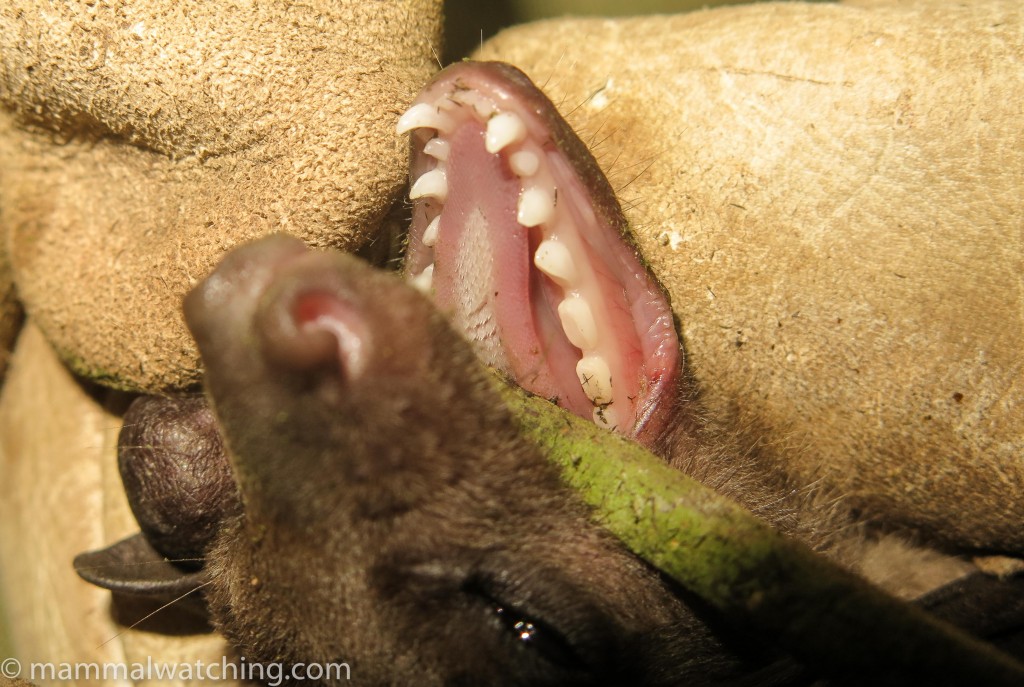
Geoffroy’s Rousette, Rousettus amplexicaudatus, teeth
We confirmed the ID after checking the shape of the back tooth (which is more oblong than square, as can be seen in the picture above) to separate it from Lescheschault’s Rousette.
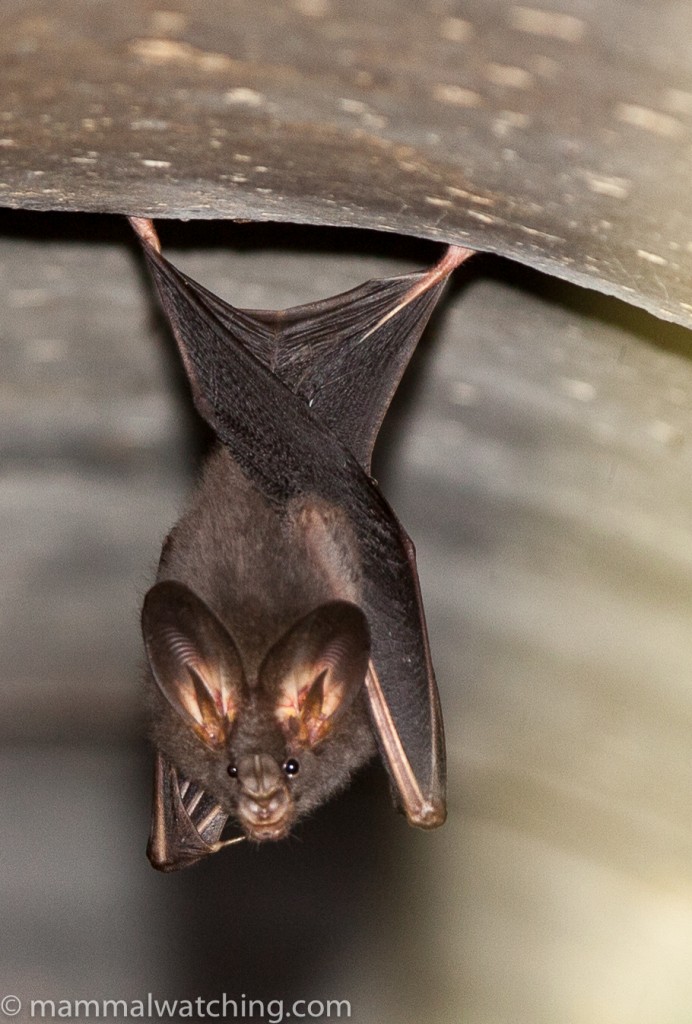
Lesser False Vampire Bat, Megaderma spasma
Lesser False Vampire: We found several roosts of these in the first few culverts along the jeep track as well as in the abandoned buildings off to the left (heading into the park) just after the entrance station, as well as in abandoned buildings at the Sub-station.
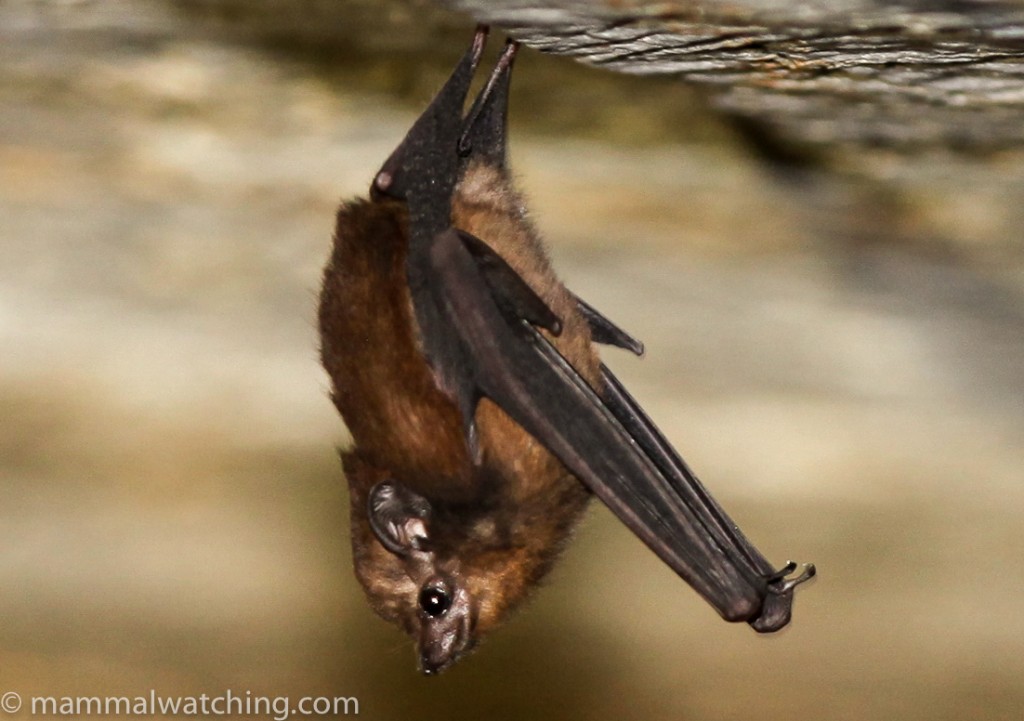
Lesser Asian Sheath-tailed Bat, Emballonura monticola
Lesser Asian Sheathtail Bat: One culvert under the middle jeep track housed this species. We caught and measured the animals and, with a forearm of just over 45mm, they ought to be E. alecto rather than E. monitcola. However, E. alecto does not occur on Sumatra so I recorded this as E. monticola.
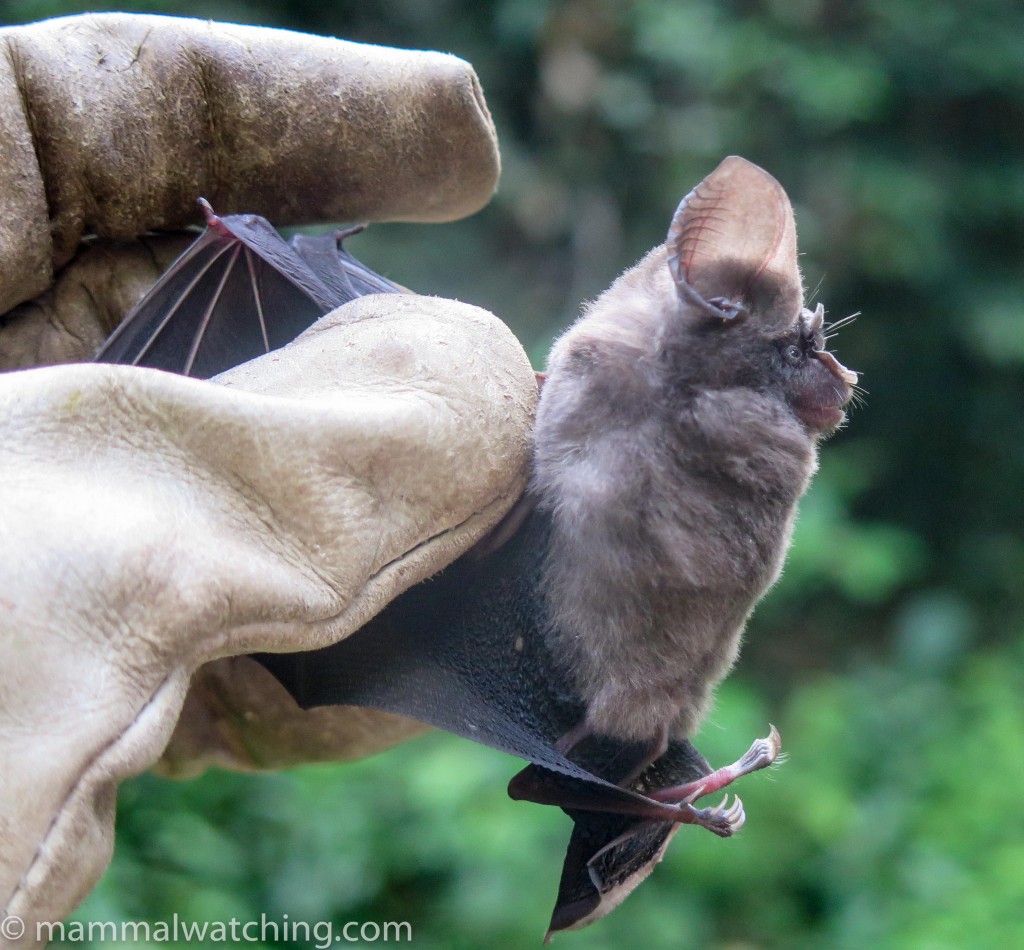
Disc (Orb)-faced Roundleaf Bat, Hipposideros orbiculus
Disc-faced Roundleaf Bat: Many of the culverts along the jeep track housed this species. We caught a few and all had a forearm of about 46.5 mm, which, together with the lack of lateral leaflets and general shape of the nose leaf suggested H. orbiculus.
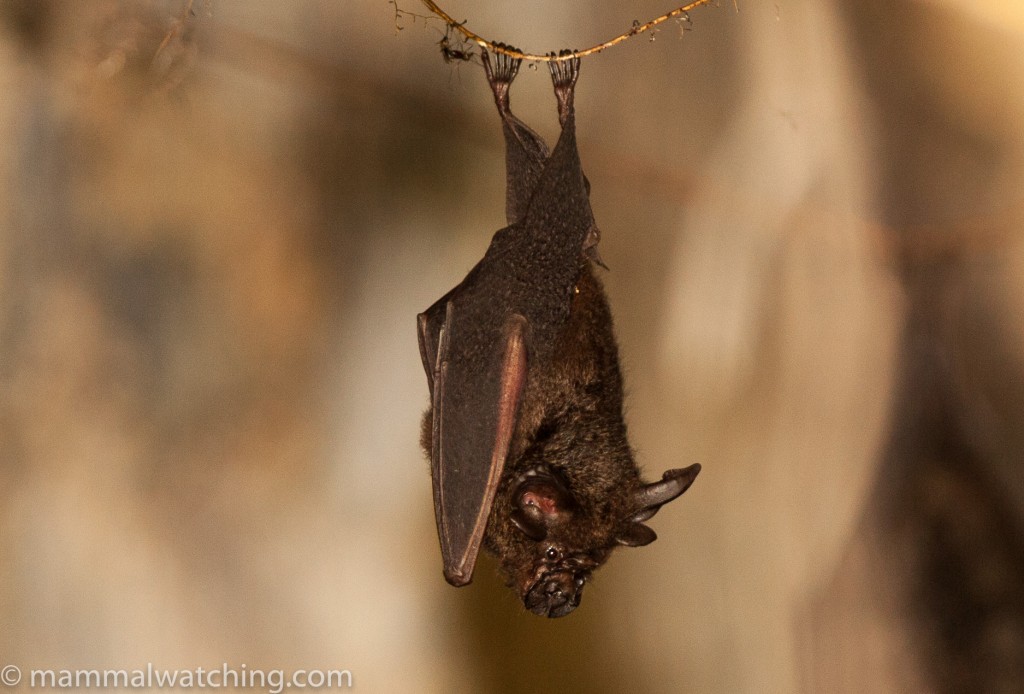
Greater Woolly Horseshoe Bat, Rhinolophus luctus
Greater Woolly Horseshoe Bat: Various trip reports have reported different Rhinolophus species in the park. We photographed one species roosting in a culvert with the emballonura, and in the next culvert along the track. We were unable to catch any and didn’t see any again. Their dark woolly fur means they were one of the two woolly horseshoe species. And our photos of the nose leaf suggested to us that these animals were Lesser Woolly Horseshoe Bats but we later discovered that only Greater Woolly Horseshoe Bats have been recorded on Sumatra.
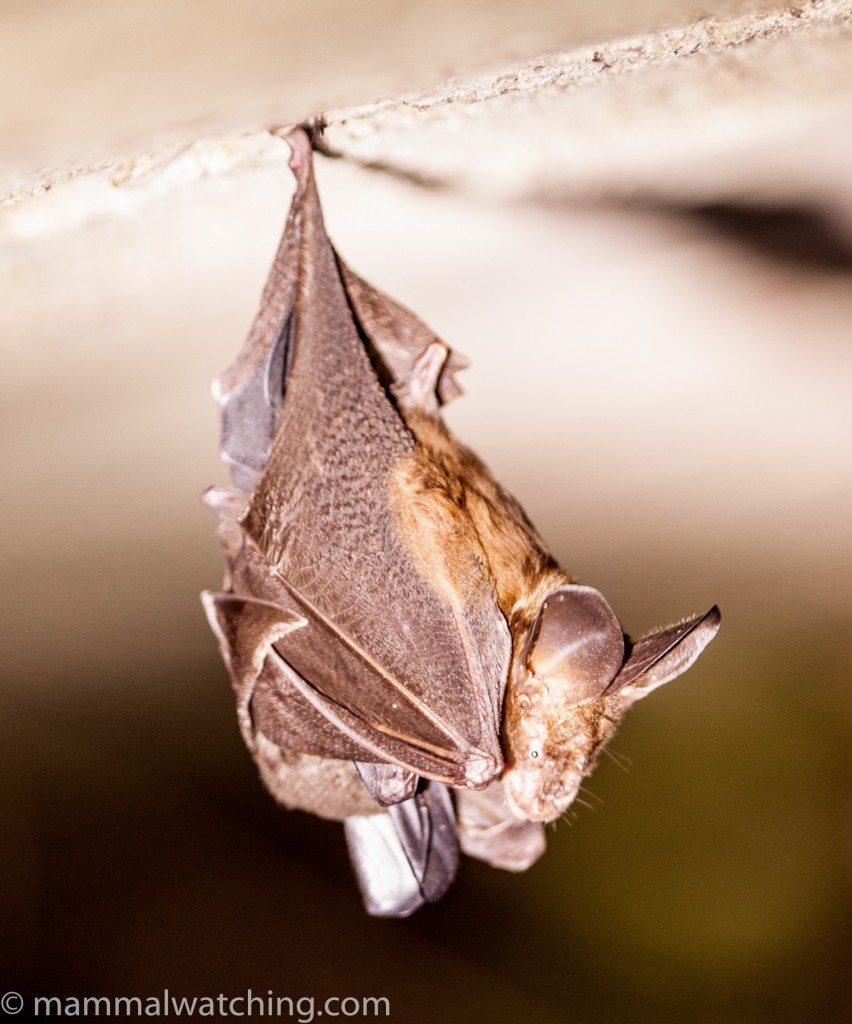
Malayan Slit-faced Bat, Nycteris tragata
Malayan Slit-faced Bat: A few of these smart bats were roosting under one of the last culverts.
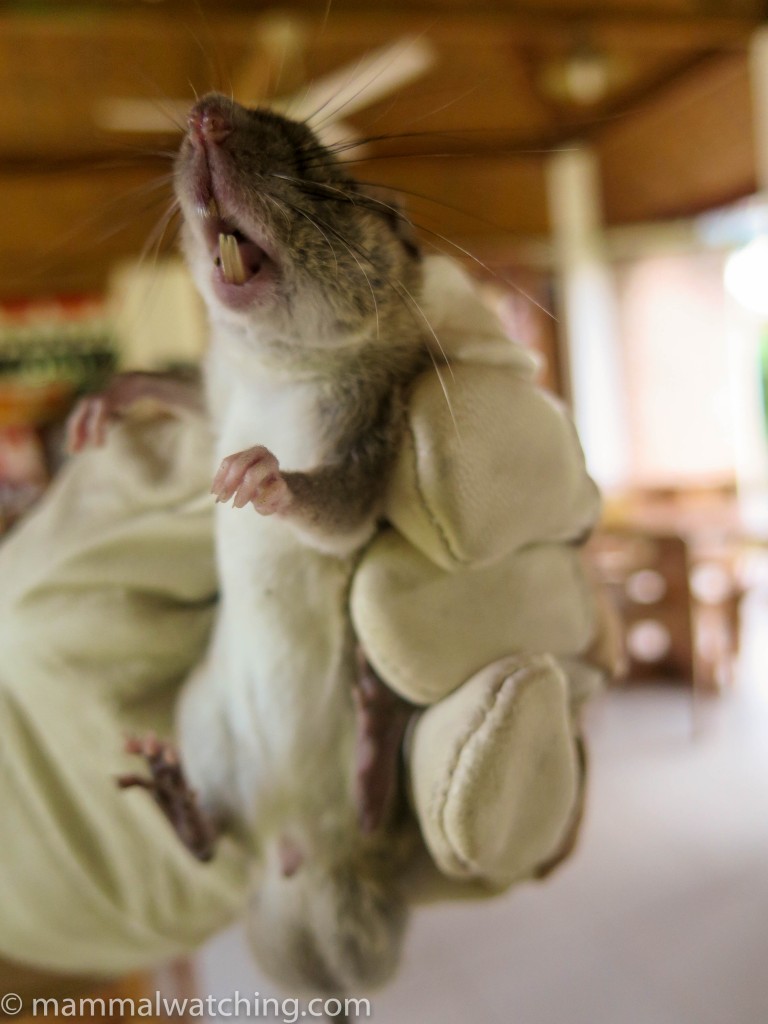
Malaysian Field Rat, Rattus tiomanicus
Malaysian Field (Wood) Rat: We live trapped two in the lodge gardens.
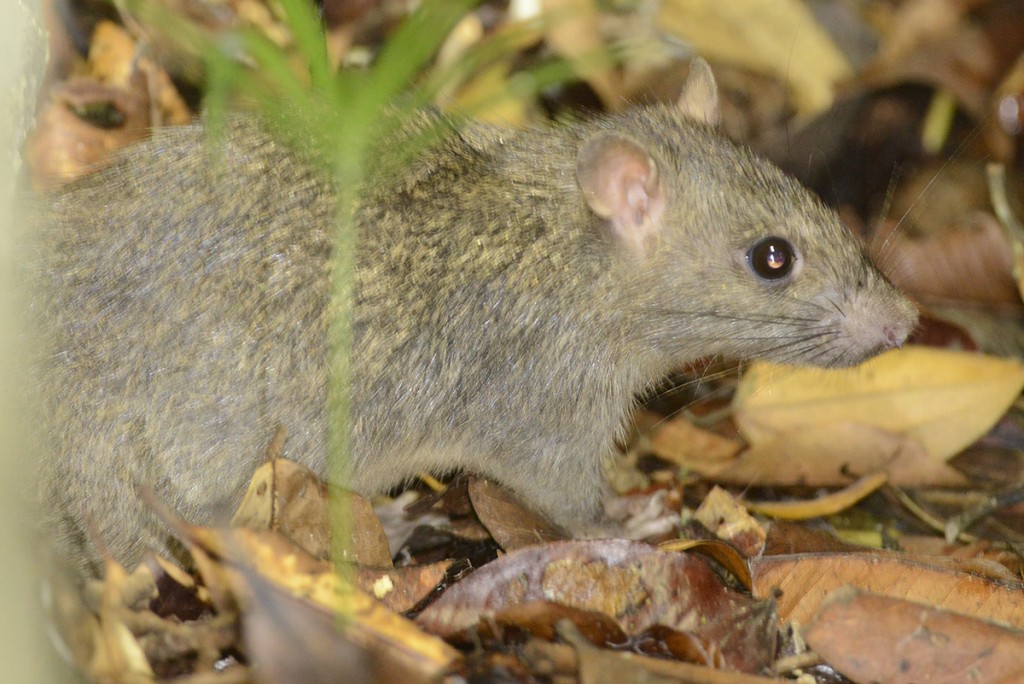
Müller’s Sundamys, Sundamys muelleriRat, photo Jean-Michel Bompar
Müller’s Sundamys: We photographed a rather large rat near the bridge that the took refuge in a hole in the bridge’s base. Shaggy, with a pale grey tail, we cannot find any other species in range fits the description though I would be happy to be corrected.
Final Thoughts and Stuff We Missed
Way Kambas has some great mammals and diversity (we saw 44 species in four days), but many are not easy to see well at least in part because the secondary forest is quite dense. So it was a rather different experience to Deramakot.
I was very happy to see two Pen-tailed Tree Shrews and this species now seems almost guaranteed at Way Kambas with some focus during a two or three night visit. I would like to have had a better view but we were also trying hard to see a Marbled Cat so didn’t spend as much time as we could have. We were lucky to see an Otter Civet though again this species seems commoner at Way Kambas than anywhere else I’ve heard of. Indeed Hari runs relatively few night tours along the river and I imagine that this species is easier to see in Way Kambas than the statistics would suggest.
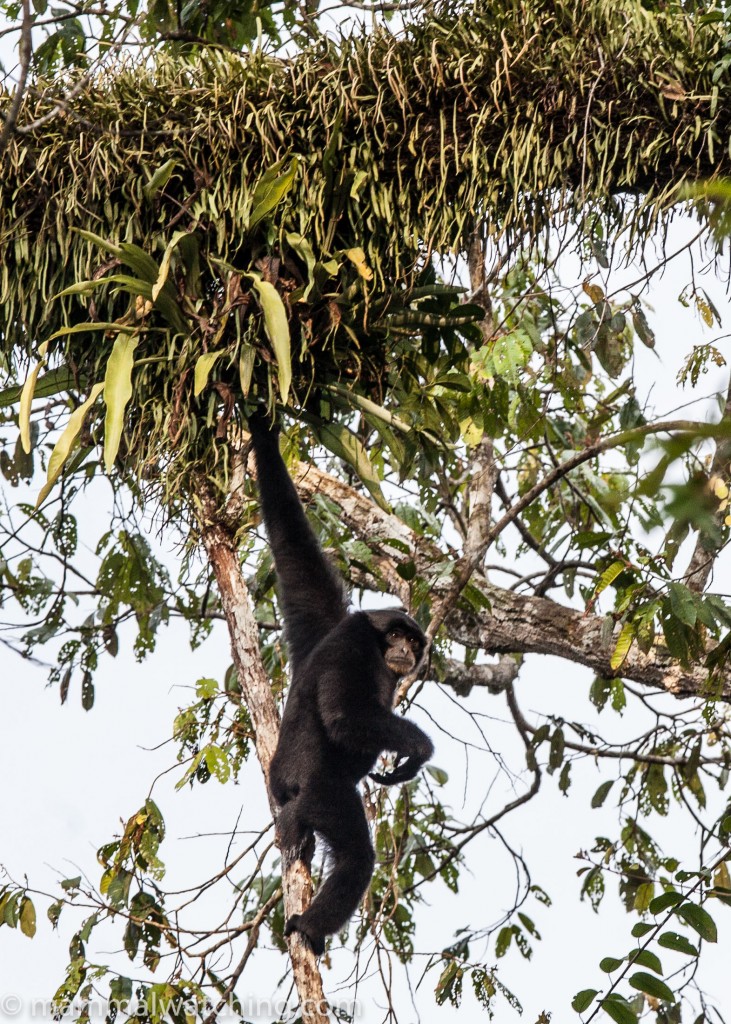
Siamang, Symphalangus syndactylus
We put in considerable effort for Marbled Cat, and on the last night Hari saw some eyeshine which bolted down a tree along the lower jeep track. This, he thought, might have been a Marbled Cat. We were unlucky I think and a visit later in the dry season – August was mentioned often – might have improved our chances.
It is hard to focus on Sun Bears at Way Kambas. They are seen every so often, sometimes along the road or the river, but no one area seems any better or worse for them. Many people see Malaysian Porcupines but we weren’t lucky. Tapirs are also possible along the river at night, though will probably be more possible once the lodge gets a quieter boat! There is basically no chance of seeing a Tiger or a rhino and a very small chance of a pangolin though here, as everywhere, it seems that any pangolin spotted by many of the locals would likely be caught and sold.
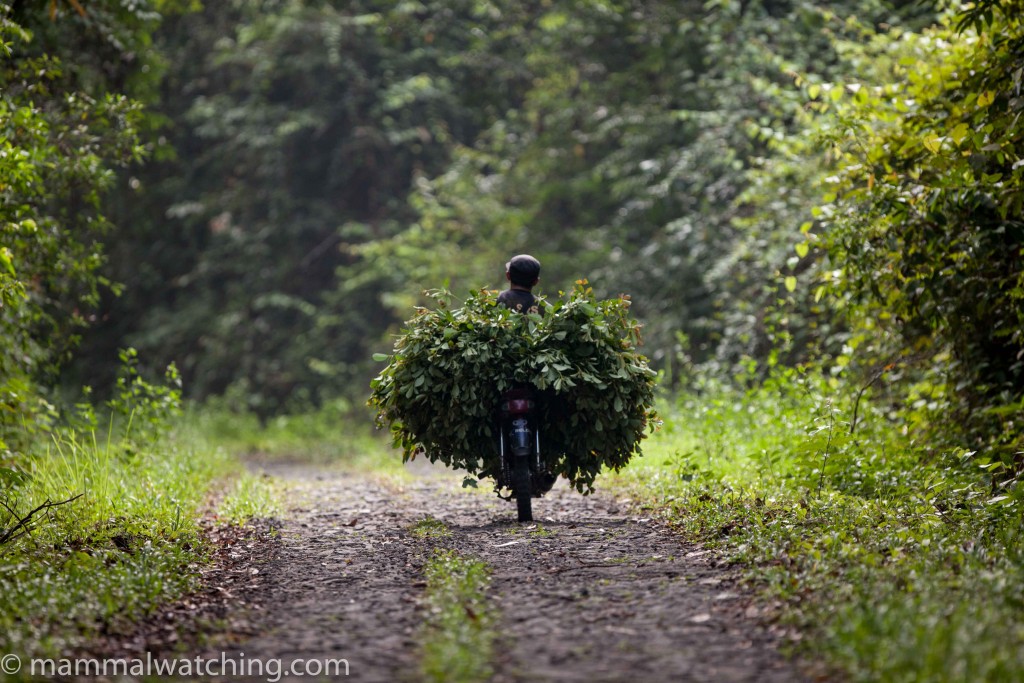
Taking food to the Rhinos at the breeding centre
A big thank you again to Hari for working so hard and spotting so much for us. I hope to return to Way Kambas one day … if I can afford it.
North Sumatra: Gunung Leuser
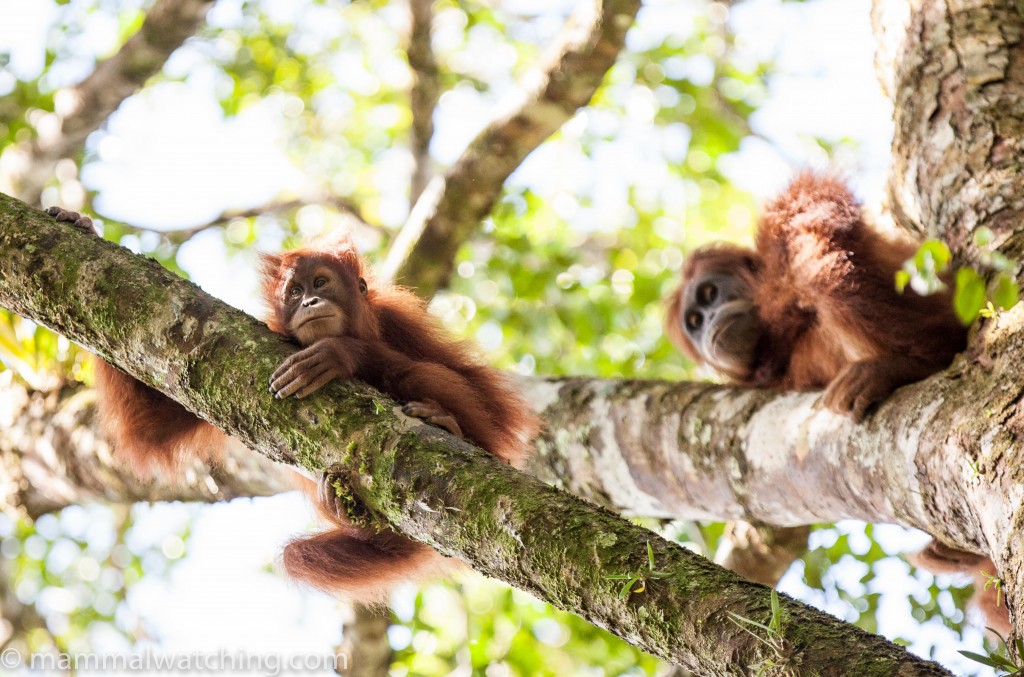
Sumatran Orangutans, Pongo abelii, Gunung Leuser
The other species I particularly wanted to see on Sumatra was the Sumatran Orangutan. So Tomer and I decided to spend our final three nights at Gunung Leuser National Park where the Orangutans were, apparently, easy to see. Jean-Michel returned home instead.
I’m surprised more mammal watchers haven’t visited this park which, in addition to the Orang Utans and endemic Thomas’s Langur, boasts a decent mammal list. Tomer had done some research and was excited to note that several bird tours had seen a Sun Bear. One bird group recommended a local guide – Johan – and so we arranged our visit through him.
To fly to Medan from Bandar Lampung we had to return first to Java. In fact it took 18 hours all up to get from Way Kambas to Leuser, the final leg of which was a painful 8.5 hour drive from Medan to Gunung Leuser. This last bit was meant to take seven hours and we aren’t entirely sure what happened because our driver was far from slow (borderline suicidal would be the first description that sprang to mind). The fact that he kept stopping for coffee and cigarettes and appeared to be running errands along the way didn’t help though and it only took seven hours on the way home.
Johan’s guest house in Ketambe – Wisma Cinta Alam – was cheap, clean and at the far edge of the village and surrounded by forest. It backs onto the river at a spot which might be good for otters. I say might because although Johan said it was otter central I was a little sceptical of his mammal information. According to Johan everything was common. He said he saw pangolins on 50% of his night walks, Sun Bears (which he insisted were a different species, the Honey Bear) were common too. He’d seen a Clouded Leopard four days ago. He’d spent several years working on Sumatran Rhinos in the park too and thought we’d need at least 15 days to see one. So while I wanted to believe him it all seemed a little too good to be true.
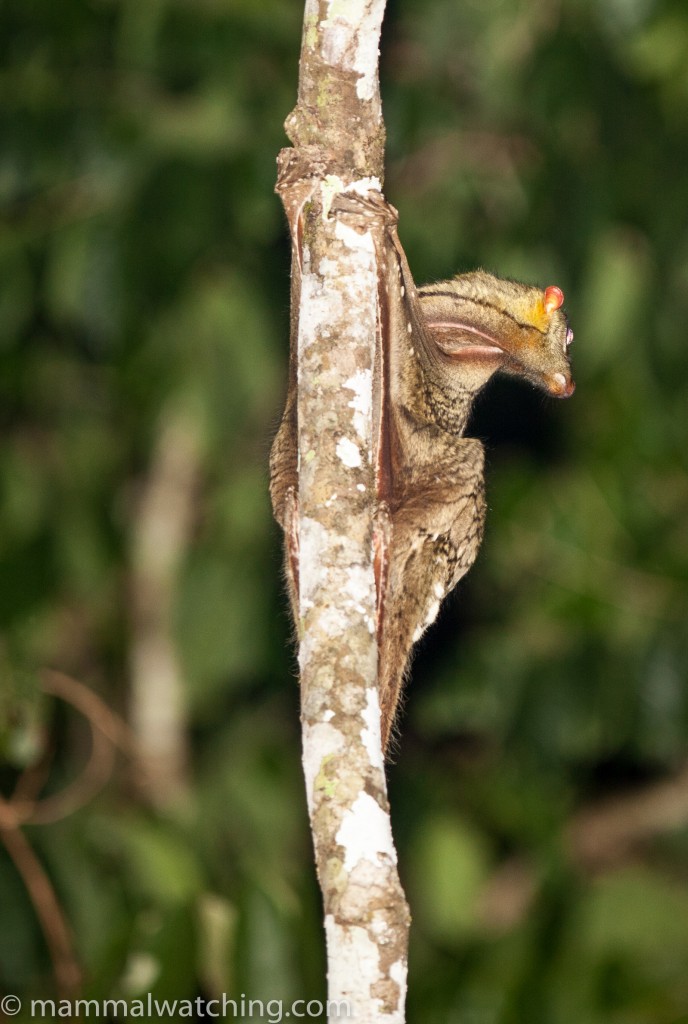
Sunda Colugo, Galeopterus variegatus
That first evening, Tomer and I took a walk along the road for an hour near midnight and had a great look at a Colugo gliding from tree to tree as well as a couple of Slow Lorises
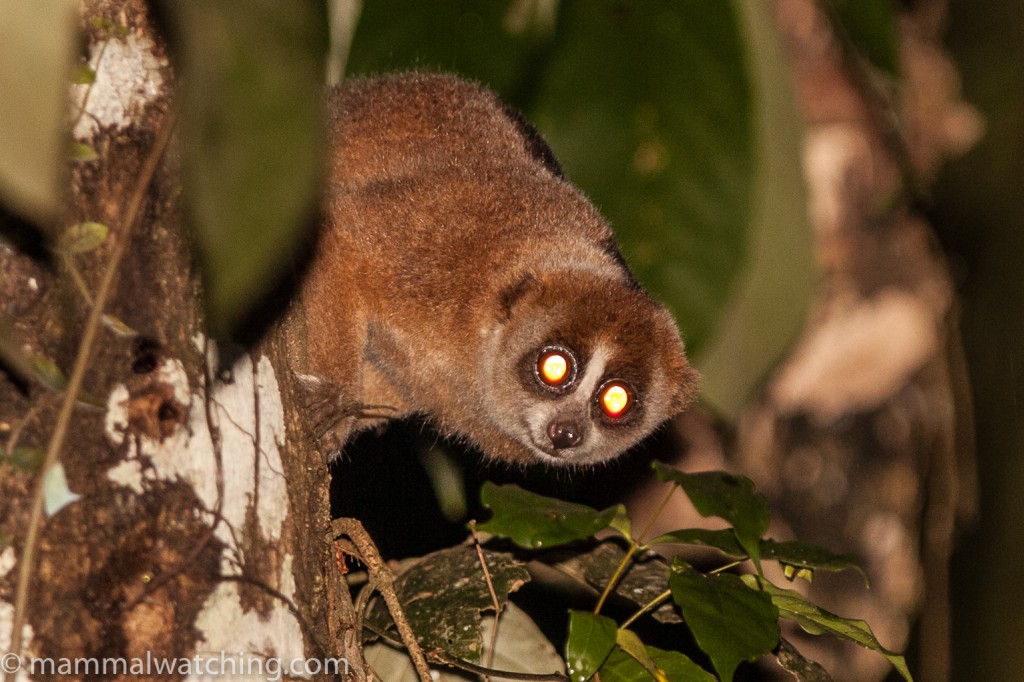
Hiller’s Slow Loris, Nycticebus hilleri
The lorises up here look a bit different to those in the lowlands. The lorises have now been split into Hiller’s Slow Loris (though I am not sure if everyone accepts the split). The picture above shows the (apparently) distinctive facial pattern of this new species (see this paper for more details).
We’d planned to spend the next two nights camping in the forest with Johan and left after breakfast.
The tourist campsite is only a 30 minute hike from the road, though we first walked for four hours through the forest looking for wildlife. Johan spotted our first Orangutans within 30 minutes and we had absolutely fabulous views of a mother and baby. They were habituated and sat out in the open.
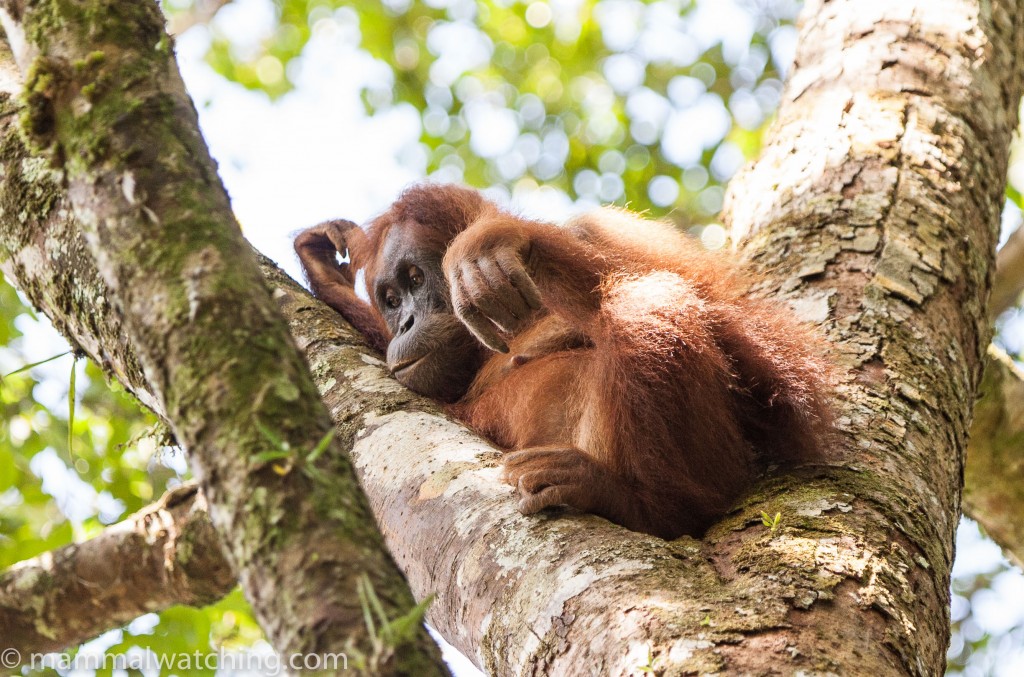
Sumatran Orangutan, Pongo abelii
A little further on Tomer spotted our first Thomas’s Langur which also posed nicely. We saw more Orangutans and langurs later on.
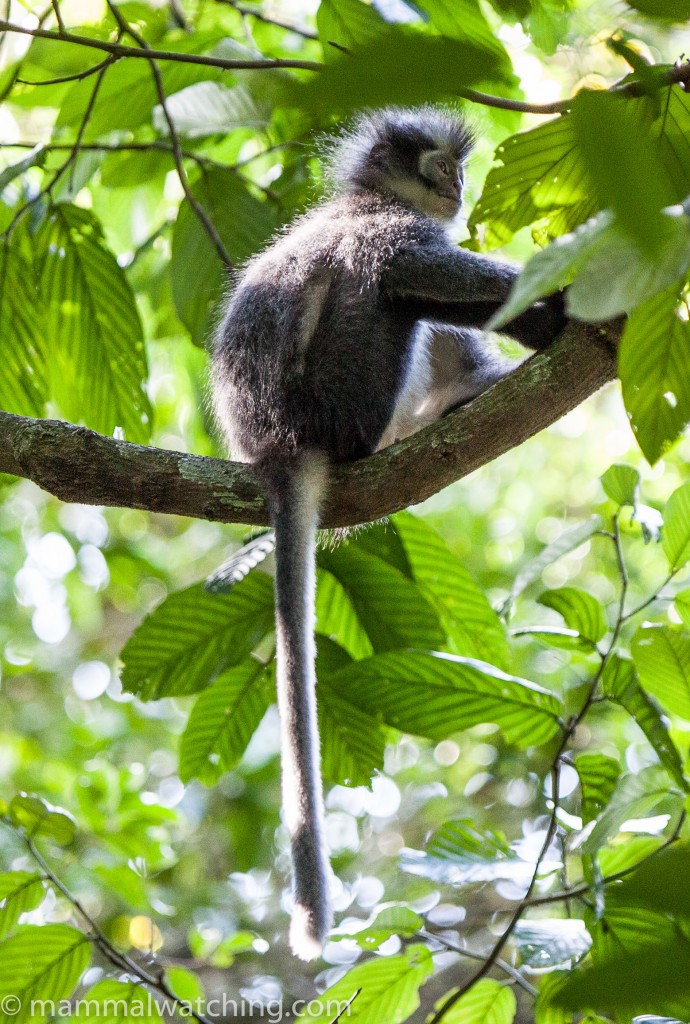
Thomas’s (North Sumatran) Langur, Presbytis thomasi
Most of the visiting tourists camp by the river. We saw only one other group in the forest and – for reasons best known to Johan or their guide – set up camp right next to them. Oh well. It was a nice spot and it was fun to wash and swim in the river and BBQ a chicken over the campfire for dinner. We rested until about 4 p.m. then took an unproductive walk through the forest, with the only mammals some Long-tailed Macaques and another Orang Utan. Johan knows this patch of forest like the back of his hand but the trails were very steep and slippery, with many leeches, so it is not an easy place to look for wildlife.
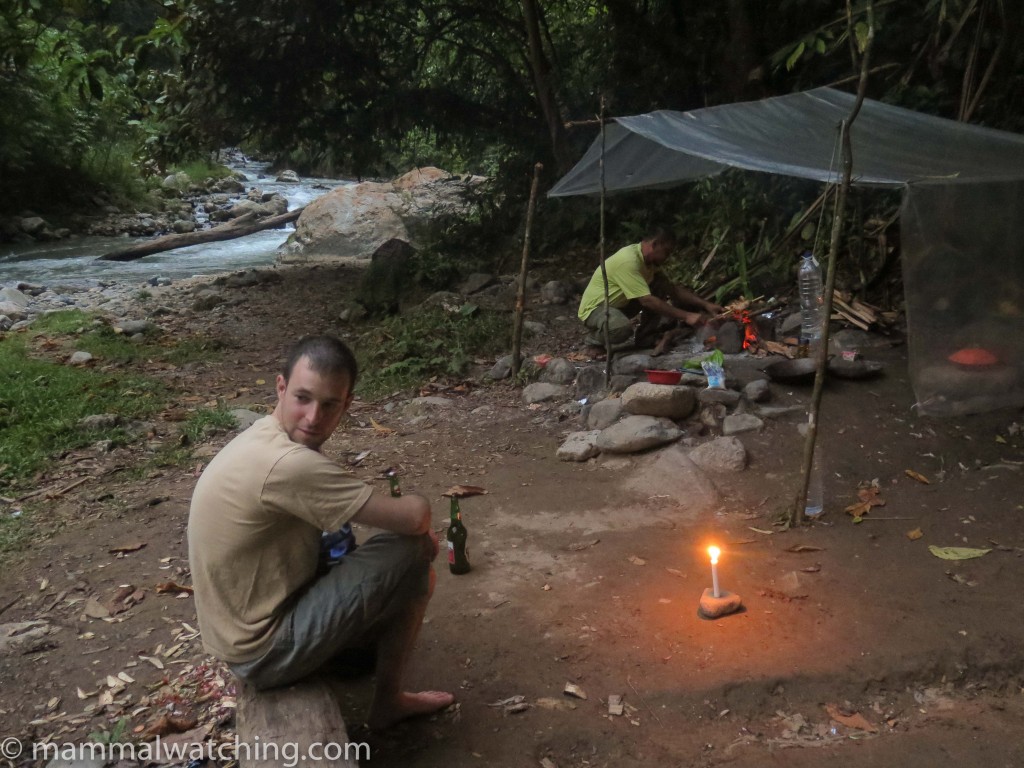
Tomer at the river
Torrential rain started at dusk and continued until almost midnight so we decided to sleep early and try for a night walk at 3 a.m. The night walk was pretty quiet: it was very hard to both look for animals and look at where we were putting our feet as we slipped and slid through the forest. Tomer spotted a Black Flying Squirrel at the top of a dead tree in a clearing, plus a Lesser Mouse Deer, and we also saw a couple of Slow Lorises on the edge of a plantation. Johan didn’t spot anything.
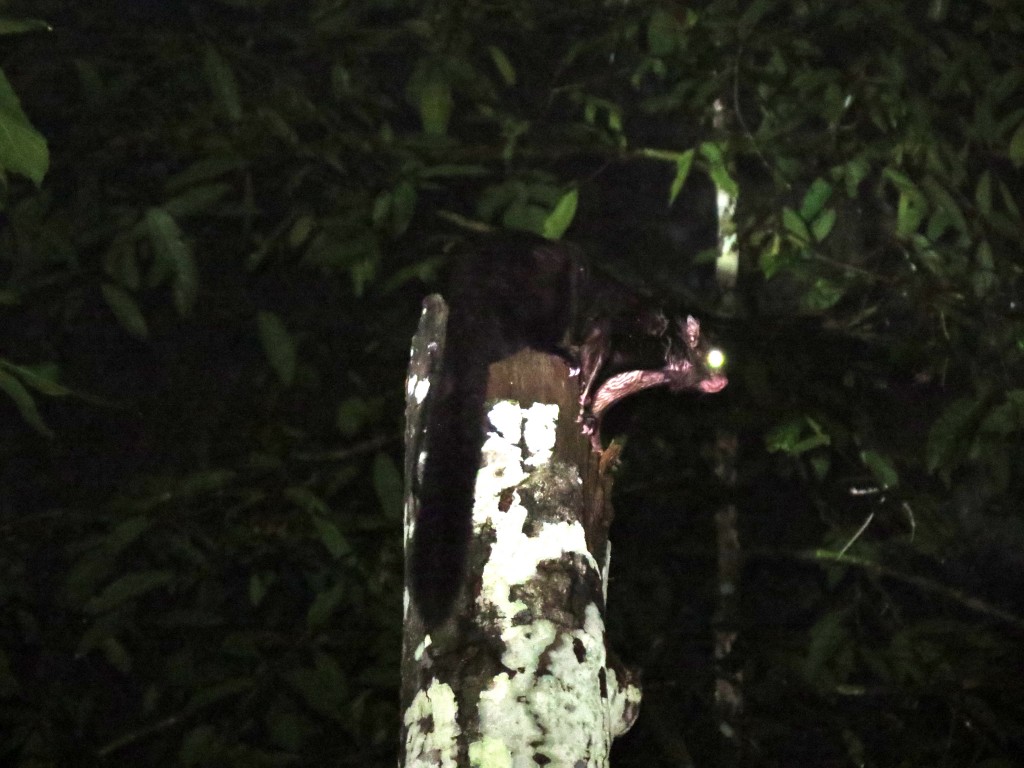
Black Flying Squirrel, Aerobes tephromelas, photo Tomer Ben-Yehuda
At dawn we heard a hoarse barking close by. Johan announced “Honey Bear”. I was sceptical but this did sound like the sort of noise I’d expect a Sun Bear to make.
Johan led us in the opposite direction to the sound. I presumed he knew a path that would loop back towards whatever was calling. But no, after five minutes, it seemed he was just heading in the opposite direction. We never fully established why he did this but by the time we realised what was going on it was too late. We returned to where we had come from and heard more, similar, calls in the distance. We followed them but they appeared to be moving quicker than we were. As we approached the area where we thought they were coming from it seemed that there were animals on either side of us. I haven’t been able to find a recording of a Sun Bear but the literature says their call may be confused with a male Orangutan and perhaps that is what we were hearing (though Johan really ought to know and was convinced we had heard a Honey Bear).
By this time it was 9 a.m. and we were covered in mud and leeches and almost back on the road. And so we decided to head back to the guest house for breakfast, which quickly became head back to the guesthouse forever. I didn’t see how the area of forest we were camping in – that was so close to the road – could be any more productive than the road itself. Indeed, both the area where we heard the “Honey Bear”, and a spot where Johan swore he’d seen a Clouded Leopard four days earlier, were both less than 100 metres from the highway. Walking and driving the road would also be a far easier way to look for mammals than battling the slopes and the leeches.
I rested for the rest of the day though Tomer walked the road in the mid afternoon and saw several Thomas’s Langurs and Orangutans at the roadside.
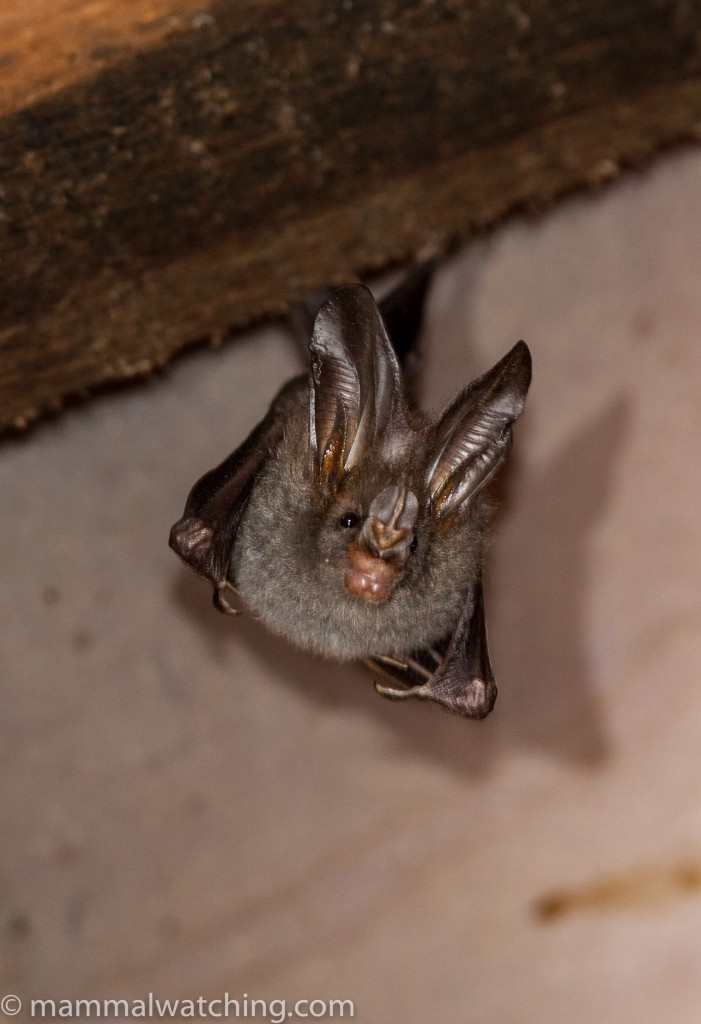
Lesser False Vampire Bats, Megaderma spasma
We walked along the road after dark. At dusk we saw many Large Flying Foxes (Pteropus vampyrus) flying very high, presumably leaving a camp higher up the mountain. And we found a roost of Lesser False Vampire Bats in a metal pipe/culvert on the right hand side of the entrance road to the Leuser Ketambe Guest House (see picture below). The pipe was a few yards along the road between the barrier and the gate house.
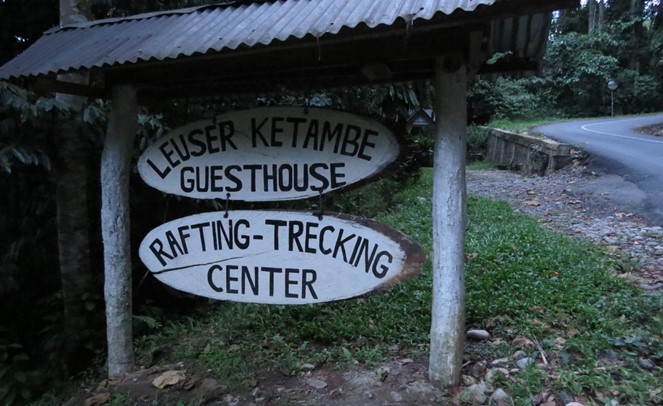
False Vampire Bat site
Johan was ready to take us for a night drive. We were too tired to stay out long, and it was raining, but we did see a couple of Small-toothed Palm Civets and a Large Flying Fox feeding in a planation close to the road.
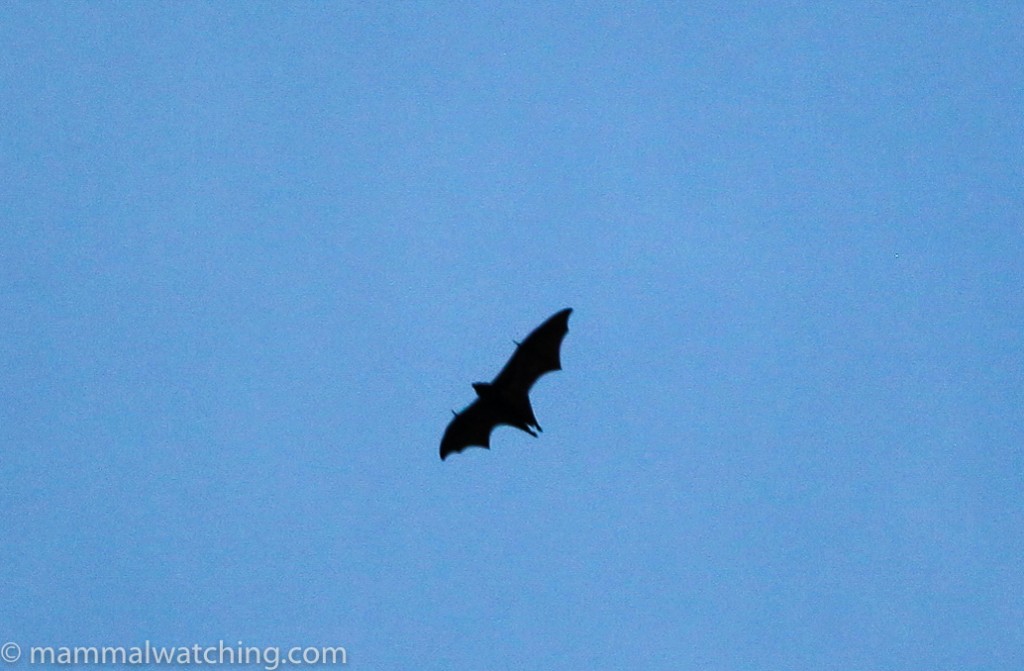
Large Flying Fox, Pteropus vampyrus
Though I am not convinced by Johan’s wildlife spotting skills or some of his stories, he was reliable, charged a very fair price and knows the forest well so he has many qualities that you would like in a guide, though you might want to plan on finding the wildlife on your own.
In 13 days on Borneo and Sumatra we’d seen a very respectable 64 species of mammals, 19 of which were new for me. I will have to go back to the region for Sun Bear and Marbled Cat, and for a proper look at an Otter Civet.
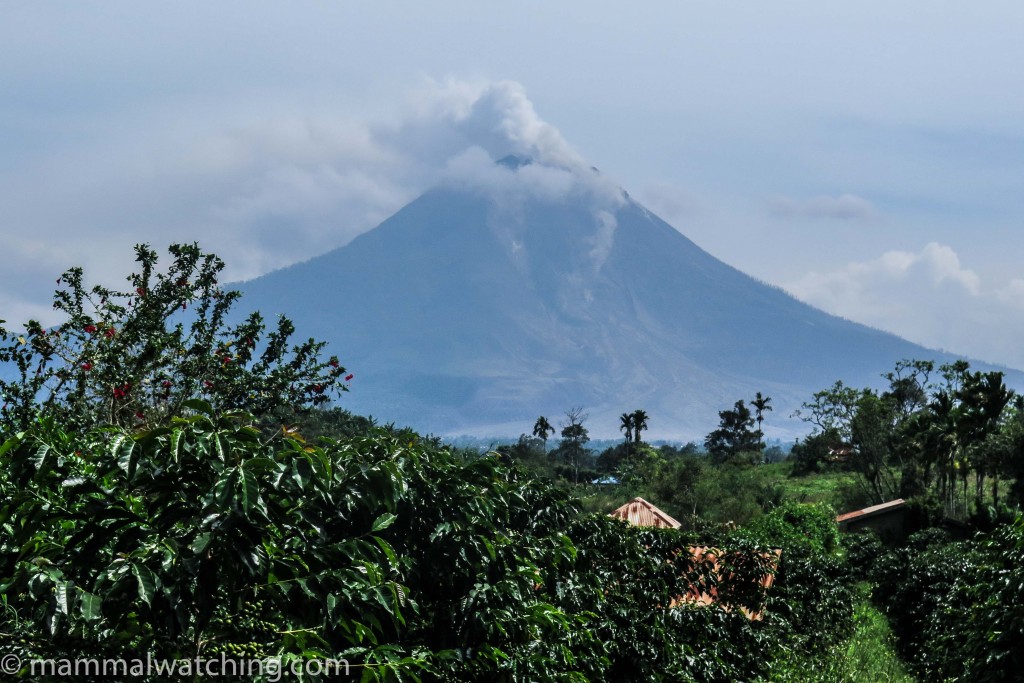
Volcano
Trip List
DK – Dermakot, WK – Way Kambas, GL – Gunung Leuser
| DK | WK | GL | |
| Black Giant Squirrel Ratufa bicolor | X | ||
| Ear-spot Squirrel Callosciurus adamsi | X | ||
| Black-striped Squirrel Callosciurus nigrovittatus | x | ||
| Plantain Squirrel Callosciurus notatus | x | x | |
| Prevost’s Squirrel Callosciurus prevostii | X | X | |
| Three-striped Ground Squirrel Lariscus insignis | X | ||
| Least Pygmy Squirrel Exilisciurus exilis | X | ||
| Slender Squirrel Sundasciurus tenuis | x | x | |
| Black-eared Squirrel Nannosciurus melanotis | x | ||
| Red Giant Flying Squirrel Petaurista petaurista | x | x | |
| Black Flying Squirrel Aeromys tephromelas | x | x | |
| Thomas’ Flying Squirrel Aeromys thomasi | x | ||
| F Javan Flying Squirrel Iomys horsfieldii | x | ||
| F Müller’s Sundamys Sundamys muelleri | x | ||
| F Rice-field Rat Rattus argentiventer | x | ||
| F Malaysian Field Rat Rattus tiomanicus | x | x | |
| F Gray Tree Rat Lenothrix canus | x | ||
| Malayan Civet Viverra tangalunga | x | x | |
| Masked Palm Civet Paguma larvata | x | ||
| Asian Palm Civet Paradoxurus hermaphroditus | x | x | |
| Small-toothed Palm Civet Arctogalidia trivirgata | x | x | |
| Bornean Striped Palm Civet Arctogalidia stigmatica | x | ||
| Binturong Arctictis binturong | x | ||
| F Banded Palm Civet Hemigalus derbyanus | x | x | |
| F Otter-Civet Cynogale bennettii | x | ||
| Leopard Cat Prionailurus bengalensis | x | x | |
| (Flat-headed Cat Prionailurus planiceps – probable) | x | ||
| Yellow-throated Marten Martes flavigula | x | ||
| F Geoffroy’s Rousette Rousettus amplexicaudatus | x | ||
| F Variable Flying Fox Pteropus hypomelanus | x | ||
| Large Flying Fox Pteropus vampyrus | x | ||
| F Minute Forest Short-nosed Fruit Bat Cynopterus minutus | x | ||
| Forest Short-nosed Fruit Bat Cynopterus brachyotis | x | ||
| F Dyak Fruit Bat Dyacopterus spadiceus | x | ||
| F Spotted-winged Fruit Bat Balionycteris maculata | x | ||
| Lesser Asian Sheath-tailed Bat Emballonura monticola | x | ||
| Lesser False Vampire Bat Megaderma spasma | x | x | |
| F Malayan Slit-faced Bat Nycteris tragata | x | ||
| F Greater Woolly Horseshoe Bat Rhinolophus luctus | x | ||
| F Orb-faced Roundleaf Bat Hipposideros orbiculus | x | ||
| Malayan Flying Lemur Galeopterus variegatus | x | x | |
| Sunda Slow Loris Nycticebus coucang | x | ||
| F Hiller’s Slow Loris Nycticebus hilleri | x | ||
| Bornean Slow Loris Nycticebus menagensis | x | ||
| F Mitred Leaf Monkey Presbytis mitrata | x | ||
| F North Sumatran Leaf Monkey Presbytis thomasi | x | ||
| Silvered Leaf Monkey Trachypithecus cristatus | x | ||
| Proboscis Monkey Nasalis larvatus | x | ||
| Long-tailed Macaque Macaca fascicularis | x | x | x |
| Sunda Pig-tailed Macaque Macaca nemestrina | x | x | x |
| F Sumatran Orangutan Pongo abelii | x | ||
| Bornean Orangutan Pongo pygmaeus | x | ||
| Agile Gibbon Hylobates agilis | x | ||
| Mueller’s Bornean Gibbon Hylobates muelleri | x | ||
| Siamang Symphalangus syndactylus | x | ||
| F Pen-tailed Tree-Shrew Ptilocercus lowii | x | ||
| Sumatran Tree-Shrew Tupaia glis | x | ||
| F Slender Tree-Shrew Tupaia gracilis | x | ||
| Long-footed Tree-Shrew Tupaia longipes | x | ||
| F Pygmy Tree-Shrew Tupaia minor | x | ||
| Eurasian Wild Boar Sus scrofa | x | ||
| Lesser Mouse-Deer Tragulus kanchil | x | x | |
| Greater Mouse-Deer Tragulus napu | x | ||
| Southern Red Muntjac Muntiacus muntjak | x | ||
| Sambar Rusa unicolor | x | x | |
| Asian Elephant Elephas maximus | x | ||
| 65 Species | 31 | 43 | 11 |
Community Reports
Siberut Island, 2025: Stuart Chapman, 3 days & 9 species including 7 endemics: Pig-tailed & Siberut Langurs, Golden-bellied Treeshrew, Mentawai Rat, Fraternal Squirrel and Siberut & Sipora Flying Squirrels.
Way Kambas, 2024: Bennett Gardner, 4 days & 30 species including Short-tailed Mongoose, Western Tarsier and a Sun Bear.
Siberut Island, Sumatra & Java, 2024: Ian Thompson, 3 weeks & 56 species including Pen-tailed Tree Shrew, Marbled Cat and Kloss’s Gibbons.
Bukit Lawang & Tapanuli, 2024: Coke Smith, 10 days & 21 species including Thomas’s & Black Sumatran Langurs plus Tapanuli & Sumatran Orangutans.
Gunung Leuser, 2024: Stuart Chapman’s note about a quick and accessible site for Sumatran Orangutan.
Sumatra primates, 2023: Sichao Ma, 2 weeks & 15 species – 13 of them primates – including Tapanuli Orangutan,Sumatran Black Langur and East Sumatran Banded Langur.
Sumatra & Java, 2023: Royle Safaris, 2 weeks & 42 species including Marbled Cat, Sumatran Orangutan and Javan Small-toothed Palm Civet.
Sumatra, Java & Bali, 2023: Royle Safaris, 17 days & 22 species including East and West Javan Langurs and Javan Small-toothed Palm Civet.
Tapanuli Orangutan, 2023: Mark Spence with species including Tapanuli Orangutan and Sumatran Black Langur.
Bintan Langurs, 2022: Mark Spence’s successful and exciting 3 days search for a Bintan Langur with other species including Silvery Langur.
Sumatran Rhino Quest, 2020-22: Royle Safaris‘ combined report of 3 adventures looking for Sumatran Rhinos, with 17 species encountered including Sumatran Tiger and – finally – Sumatran Rhino. Check out Chris Scharf on the mammalwatching podcast who was on all these trips.
Natuna Islands, 2021: Mark Spence, 1 week with mammals including Natuna Langur, Small-toothed Palm Civet, Slow Loris and a strange looking Giant Squirrel.
Way Kambas, 2019: Hugh Lansdown, 5 days & 22 species including Sun Bear, Malayan Weasel and Pen-tailed Tree Shrew.
Sumatran Rhino Trip, 2019: Royle Safaris, 3 weeks & a fascinating report of a “new” population of Sumatran Rhinos which were heard but not seen plus the presence of 26 other species detected.
Siberut, Mentawai Islands, 2018: Mark Spence, 5 days with some nice mammals including Siberut Flying Squirrel, Kloss’s Gibbon and Mentawai and Pig-tailed Snub-nosed Langurs.
Singapore, Java, Malaysia and Sumatra, 2019: Anita Ericson and Lars Petersson, 6 weeks & 63 species including – in Sumatra – Pen-tailed Tree Shrew, Lar Gibbon, Binturong and Serow.
Sulawesi and Kerinci-Seblat, Sumatra (with a bit of Bali and Java too), 2018: Tomer Ben-Yehuda, 2 weeks & 30+ species including Babirusa and Bear Cuscus.
Way Kambas (Sumatra) and Tangkoko (Sulawesi), 2018: Andreas Jonsson, 9 days & 32 species in Way Kambas, and another 5 in Tangkoko, including Pen-tailed Tree Shrew, Trefoil Horseshoe Bat and Celebes Dwarf Squirrel.
Indonesia, 2016: Richard Webb, 2 weeks & 44 species including Western Tarsier, White-bearded Gibbon, Irrawaddy Dolphin and some nice bats.
Gunung Leseur, 2016: Evan Greenspan, 10 days with species including Orangutan and Mitred Langur, but no cats.
Gunung Kerinci and Tapan Road, 2016: Richard Webb, 5 days & 13 species including Mitred Langur, Siamang and Niobe Ground Squirrel.
Way Kambas, 2014: Paul Carter, 1 week & 31 species including Pen-tailed Tree Shrew, Malaysian Slit-faced Bat, Yellow-throated Marten and a probable Marbled Cat.
Sumatra & Komodo, 2014: Royle Safaris, 2 weeks & over 50 species including Marbled Cat, Siamang and Binturong.
Way Kambas & Indonesian Borneo, 2014: Ian Loyd, Lorna Watson and Steve Morgan, 2 weeks & 36 species including Feather-tailed Tree Shrew, Malayan Tapir, some nice bats and a probable Marbled Cat and Banded Linsang.
Indonesia (Java, Sumatra, Sulawesi, Borneo and Bali), 2013: Dave Redfield and Richard White (INDRI tours), 22 days & 52 species including Pen-tail Treeshrew, Otter Civet and Mitred Langurs (all in Way Kambas, Sumatra).
Java & Sumatra, 2013: Richard Webb, 2 weeks & 38 species including all the Javan specialty primates and Javan Small-toothed Palm Civet, plus – on Sumatra – Banded Palm Civet, Flat-headed and Marbled Cats.
Sulawesi, Sumatra and a bit of Java, 2012: Dominique Brugiere, 7 weeks & plenty of mammals including Babirusa, Sulawesi Warty Pig, Anoa, Banteng and Javan Ferret Badger.
Way Kambas, 2012: Richard Webb, 1 week & 26 species including Marbled Cat(s) and a Banded Palm Civet.
Sumatra, 2011: Carmen and Torbjorn Lundqvist, 3 weeks & 27 species including Sumatran Orangutan, Thomas’s Leaf Monkeys and Mitred Langurs.
Indonesia (esp. Sulawesi), 2009: Steve Anyon-Smith, 1 month & 20 mammals including Sulawesi Tarsier and Bear Cuscus.
Greater Sundas (West Malaysia, Borneo, Sumatra, Java), 2008: Tim Mitzen, 2 months and 55 mammals including a Sun Bear and Banded Palm Civet. A full trip report is here.
Also See
Suggestions for guide for Bukit Lawang, October 2024
RFI Way Kambas, May 2024
Sumatran Striped Rabbit seen on Gunung Kerinci, Novembver 2023
Checklist of the Mammals of Indonesia (March, 2020)
RFI Taman Nasional Bukit Barisan Selatan (April, 2019)
Sumatra and its mammals (January, 2015)
Indonesia Rat ID help (August, 2014)
RFI on Way Kambas, Sumatra (April, 2011).


Leave a Reply
You must be logged in to post a comment.